The following is a
Unique Homes Online Exclusive
During the mid-year height of the Covid-19 pandemic, real estate agents comment on how the market stood, and in some cases prevailed, under enormous pressure.
This past Fall, luxury real estate agents from across the country spoke on Unique Homes’ first Zoom panel to discuss topics from the recent article “Space: The New Currency,” from Unique Homes Magazine’s recent Fall issue, written by Camilla McLaughlin. On this exclusive virtual panel, agents were able to discuss how the real estate markets of America endured (and continue to endure) through the turbulence that the Covid-19 pandemic has caused. Throughout the discussion, these experienced panelists spoke on the changes their area(s) have undergone and the how the pandemic has affected the homebuying process. We’ve highlighted some of our distinguished panelists and their unique experiences below.

Mauricio Umansky, Founder/CEO of The Agency
Los Angeles, CA
In the beginning of “Space: The New Currency,” Mauricio Umansky, Founder and CEO of The Agency, notes that in the midst of the pandemic, consumers who were staying at home also found themselves asking impactful questions regarding their homes and their futures: where am I sequestering versus where am I at home? What do I want my home to look like? What do I want my second home to look like?
As one of the opening speakers, Umansky adds that though many of these questions may not be answered right away, the pandemic proved to be a catalyst for many potential home buyers to start a dialogue with their local real estate agents. “Sequestering at home, stay in, shelter in place, whatever it is we want to call it, has caused a conversation that is equal amongst everybody, whether it’s politically driven, whether it’s answering ‘what do I want to do with my life?’ and understanding that we can now work and operate from anywhere.”
Courtney Hampson, Vice President of Marketing
Palmetto Bluff, SC
Palmetto Bluff is a community in coastal South Carolina that caters to a mix of primary and vacation homeowners. Courtney Hampson, Vice President of Marketing for Palmetto Bluff, says on the panel that at the beginning of the pandemic many residents were already staying in Palmetto Bluff due to Spring Break, and were mandated to stay due to the shutdown. Many stayed until May when the state began opening up again, and there were several instances where those who extended their stay ended up moving to Palmetto Bluff full time. About a particular couple from New York with young children, Hampson says “They literally walked down the street into our real estate office, went on our tour, looked at available homes, closed two days later, our fastest closing ever, and that was it. ‘This is where we are,’ they said, ‘This is the plan now.'”
During the panel Hampson also stated that the utilization of virual tours and showings became more widely utilized, so much that they had to include the option on their website right away on their website.” She also noted that in the midst of everything, they found that buyers were buying almost like they were suffering from FOMO, or a Fear of Missing Out. “[Clients] are booking their stay at the hotel first, and … they have almost a fear of missing out. They’re not waiting to get here to look at real estate — they’re doing that virtually, going under contract and seeing their property the first time they come to visit.”

Carrie Wells, Coldwell Banker Mason Morse Real Estate
Aspen, CO
Though located on the opposite side of the United States, Carrie Wells of Coldwell Banker Mason Morse Real Estate in Aspen, Colorado experienced similar situations as Hampson had in South Carolina. March is typically the latter part of the state’s skiing season, but due to the pandemic the season was cut short, and those visiting found themselves sequestering in Aspen — and staying. She remarked that you can see this reflected in the school district alone, where 175 new students were admitted and a weight list was created for the Aspen Country Day School, Aspen’s main private school. She also noted that with the help of Matterport virtual tour technology many sales were able to happen, as clients wanted to be able to visit openings safely.
Wells remarked about her own experience with a New York family who stayed in Aspen until the summer. “He said, ‘I never realized that Aspen is so enjoyable in April and May,’ which are normally our off-season months. … People have experienced being here year-round, when they normally would not be here, and there’s so much to do other than downhill skiing that I think regardless of what happens with our winter, we’re still going to see our market continue to be strong.”
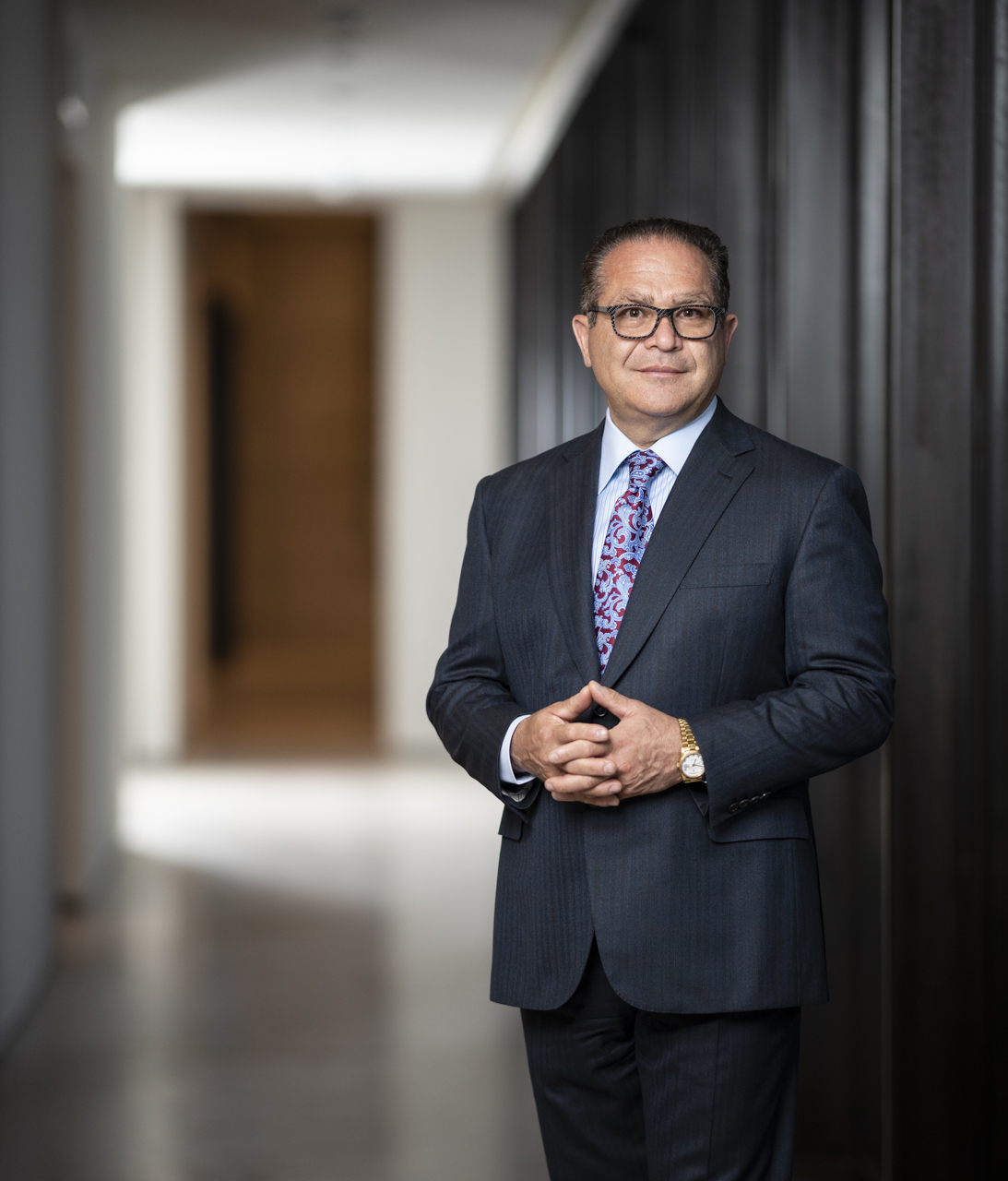
Frank Aazami
Russ Lyon Sotheby’s International Realty
Scottsdale, AZ
The title of the article “Space: The New Currency,” as well as the main point of discussion for the panel, was inspired by profound statement by Frank Aazami of Russ Lyon Sothebby’s International Realty. During the panel Aazami notes that when the pandemic began and people were sequestering, he noticed that areas that were previously difficult to sell beforehand, regions outside of Phoenix and Scottsdale such as Fountains Hills, Cave Creek, etc, were now like beacons that buyers were gravitating towards. Before there were no sales north of $3 million, but eventually there were closings reaching upwards of $4 and $6 million. The reasoning for this market change? Space!
In the article Aazami notes that from his region of Scottsdale, Arizona, his experience during the pandemic that no matter what buyers were generally looking for, a vacation home, relocation refuge, etc., the key point he saw was that consumers were looking for a safe haven, with plenty of space. Not only that, but consumers are also requesting specifics when it comes to this space in order to make their purchases personal and customized to their lifestyles, from multiple offices and indoor gyms to view decks and larger patios.

Chris Bernier, Churchill Properties
Boston’s North Shore, MA
Located just 30 minutes outside of Boston, Chris Bernier of Churchill Properties notes during the Zoom panel that despite the usual trends of buyers looking for smaller, more minimalistic style homes, space really is the new currency. He affirms that many buyers in his market are flocking toward the larger homes. These market shifts are no doubt due to the pandemic shifting priorities, and continues to show
James Torrance, Keller Williams Luxury International
Palm Beach, FL
James Torrance from Palm Beach, Florida has much to say about the pandemic has shifted Florida into more than just a retirement or snowbird refuge, seen in these clips from the Zoom discussion. He notes further that in fact a large wave of buyers from California and more specifically Chicago brought interest to the area and helped close several sales, a rarity in his area. What was also interesting that he notices are the importance of the private schools and districts in South Florida, as he mentions that many buyers were shopping around different homes once they had found a school system they liked, then picking from available homes nearby.
This, alongside his points about the importance of homes with multi-functional spaces such as guesthouses and just the overall outlook on how the market has shifted, highlight just how much action Florida has seen in the past several months due to Covid-19’s effect on real estate.
Roxann Taylor, Engel & Völkers Dallas Forth Worth
Dallas, TX
As an real estate agent with 40-plus years of selling experience, Roxann Taylor of Engel & Völkers Dallas Forth Worth was a fountain of wisdom toward the end of the virtual panel. She highlighted much of which was similar to what the other panelists had noted, including buyers prioritizing homes with large space as opposed to downsizing, putting houses on the market through a near fully-virtual process, and much more.
For More Unique Homes Online Exclusive content, click here.

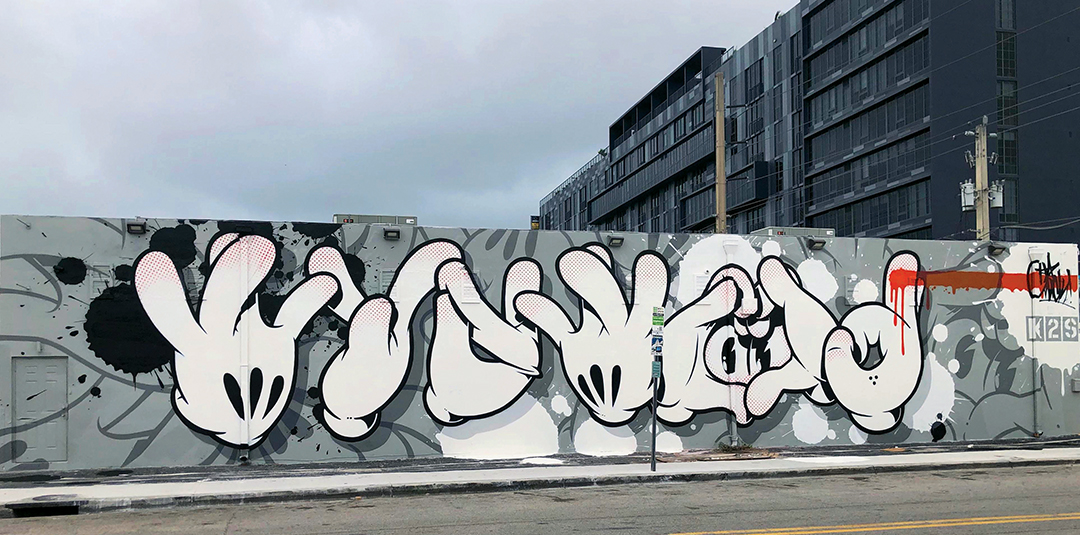
Slick, a native of Hawaii, painted this mural on the exterior of the Museum of Graffiti in Miami.
Photo courtesy Museum of Grafitti.
Its earliest practitioners were considered criminals, but now the work of some graffiti artists hangs in the nation’s most prestigious museums.
After society’s initial outrage over acts of vandalism in the name of creativity, art enthusiasts begrudgingly acknowledged that some wayward, urban painters were genuinely gifted. Over time, graffiti and street art earned a place in prestigious collections, private galleries and museums like the Museum of
Contemporary Art (MOCA) in Los Angeles and Whitney Museum of American Art in New York.
While graffiti is often viewed as an American-born genre, Michael Rooks, a curator of modern and contemporary art at Atlanta’s High Museum of Art, provides some historical context. “Graffiti and street art have their origins in the history of 20th century art — from Dada wherein text replaced image to inveigh against WWI on the streets of Zürich, to the Mexican muralist movement’s large-scale murals in post-revolution Mexico City, to Les Affichistes artists whose affiches lacérées (layers of torn posters and advertisements) were literally sourced from the streets and walls of post-WWII Paris.”
The evolution of American street art has been well documented in L.A. and New York, but the acceptance of this form of artistic expression has also occurred in Philadelphia, Miami, Chicago, and San Francisco.
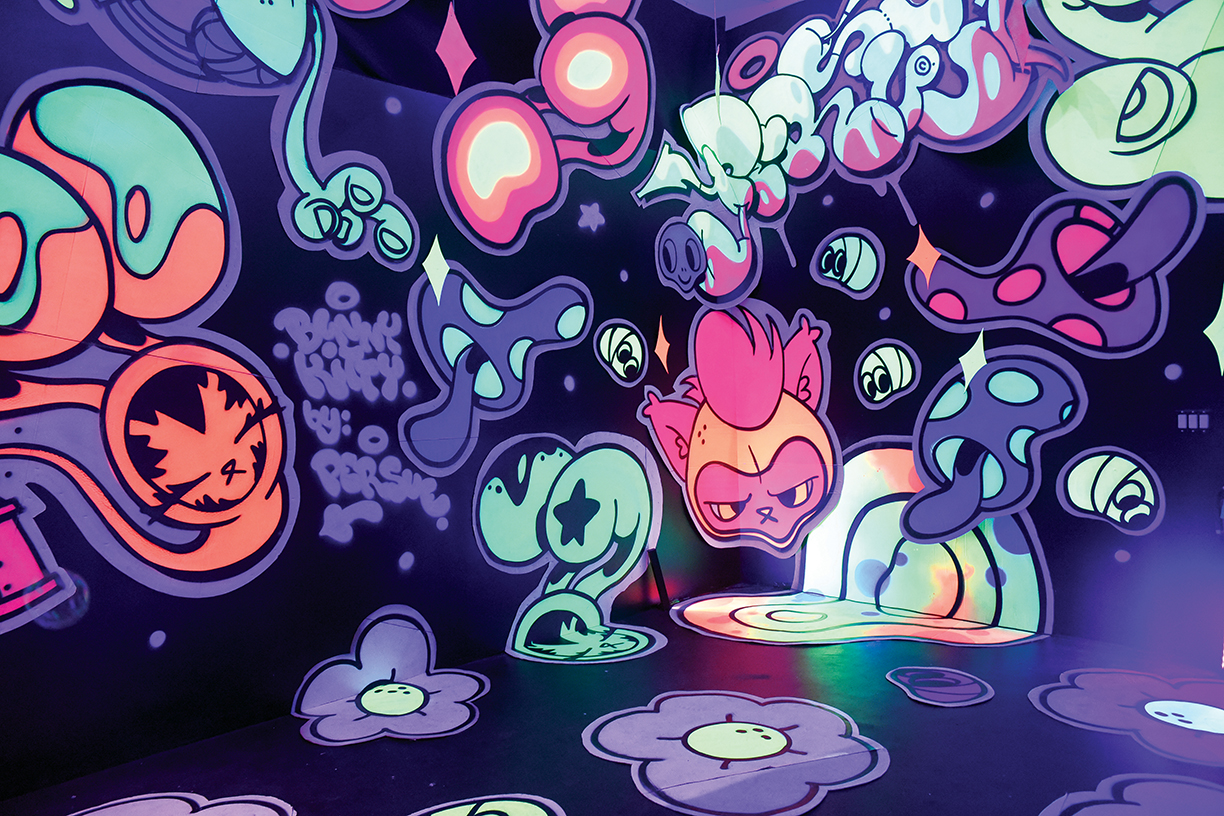
“Bunny Kitty’s Dreamstate Room” is a vibrant, playful work from artist Persue.
Photo courtesy Museum of Graffiti.
Some street artists are commissioned as muralists, a transition that monetizes and legitimizes their work, before eventually being discovered by curators. Ultimately, gallery representation leads to their art appearing in chic restaurants, hotels and private collections. Artists like Keith Haring, Jean-Michel Basquiat and Shepard Fairey — all once confined to the fringes of the art world — became creative celebrities. In L.A., the exclusive fashion boutique of Elyse Walker features artwork by RETNA, one of the most prominent local street artists, while superchef David Chang hangs the work of David Choe in Majordomo, his popular downtown restaurant. The city’s Mayfair Hotel features the work of a different street artist on every floor — resulting in diverse visual experiences for guests — and is a tribute to the depth of talent in the region.
The historic Mayfair, site of the first post-Academy Awards party in 1929, has been transformed into a trendy setting showcasing street art, curated by artist-in-residence Kelly “RISK” Graval. The Louisiana-born artist became one of L.A.’s most influential graffiti stylists and was among the pioneering artists to transition from the street to the gallery, as well as entering the worlds of fashion design and music video.
RISK’s own work is represented by a Buddha-inspired installation on the second floor and one of his murals will eventually soar above the 15th-floor pool deck. “I selected my “Metallic Tissue” series, which consists of a body of work that I paint on panels built out of repurposed spray cans,” reports RISK, who states, “They’re my imprint on society as an artist, my DNA.” He also installed some of his unique neon work in the lobby, which suits the vintage of the building. Overall, nearly 100 pieces throughout the hotel represent the diversity of L.A.-based graffiti artists and muralists like DEFER, Billy Morrison and Shepard Fairey, whose breakout work was the Barack Obama “Hope” imagery from the 2008 presidential campaign.
“There was a time when graffiti artists were a small underground subculture,” explains RISK, but adds, “The powerfully dynamic art sparked a younger generation and it exploded.” He acknowledges that street art festivals and museum exhibits helped elevate the genre within the polite corridors of the art world, but that true recognition has been stubborn.

Neon work from RISK, the artist-in-residence at The Mayfair Hotel in L.A. Photo courtesy the Mayfair Hotel.
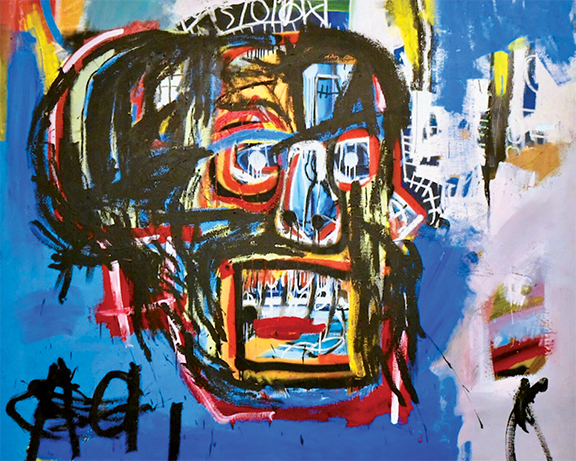
This untitled painting of artist Jean-Michel Basquiat sold for $110.5 million at auction. Photo courtesy Museum of Graffiti.
“It was time for a new generation to take over. The old guard and practices of art began to change,” insists RISK, who suggests progressive hoteliers are helping idiosyncratic artists to find an audience. “Hotel art was becoming stale, kind of like Muzak in elevators in the ’80s, and needed a new approach,” says the veteran artist. “Boutique hotels like The Mayfair are ahead of the curve and breathe fresh air into an exciting future for art, artists, and art enthusiasts,” says RISK.
Roger Gastman, an urban anthropologist and historian, is a leading authority on street art who counts The History of American Graffiti and Street World: Urban Art and Culture from Five Continents among his 50 books. Gastman remembers his own discovery of self-expression — through a spray paint can in the early 1990s — as a defining moment in his young life.
Gastman, whose first book, Free Agents: A History of Washington, D.C. Graffiti, documented the local culture he experienced in his youth, reports there is a distinction between graffiti and street art. “Graffiti is very name-based, very ego-driven, while street art is more image-based and involves additional tools and techniques,” says Gastman, but notes that both have their roots in vandalism. “Street art is a safer name and is more digestible to the public, but graffiti and street art are kissing cousins on the same playing field,” he muses.
“So much of this work is fantastic and deserves to be seen in a different light, collected and respected,” says Gastman, who laments, “A majority of galleries and museums still don’t accept this kind of art, look at it seriously or believe it should be shown.” Demographics, however, are driving attitudes, suggests Gastman. “People in their 30s and 40s grew up with graffiti, tattooing and skateboarding — it’s everywhere, in fashion, music and advertising — and it resonates with them.”
Last year, Gastman spearheaded the New York edition of Beyond the Streets, a massive 100,000-square-foot exhibition of prominent graffiti artists in Brooklyn, following a similar event in L.A. in 2018. “We basically built our own museum and 200,000 people walked through the doors,” he explains, adding, “It showcased graffiti and street artists, giving them respect and presenting their history in the proper light.”
Miami, whose Wynwood Arts District is defined by vibrant, multicultural murals, is a city with a strong tradition of street art, and its Museum of Graffiti pays homage to the approachable medium. Museum co-founder Allison Freidin explains, “Our goal is to celebrate a group of artists previously marginalized because of the stigma associated with graffiti,” and reports the Miami institution is the only one in the world exclusively dedicated to graffiti art. “Previously, there was no place to learn about these artists,” she adds.
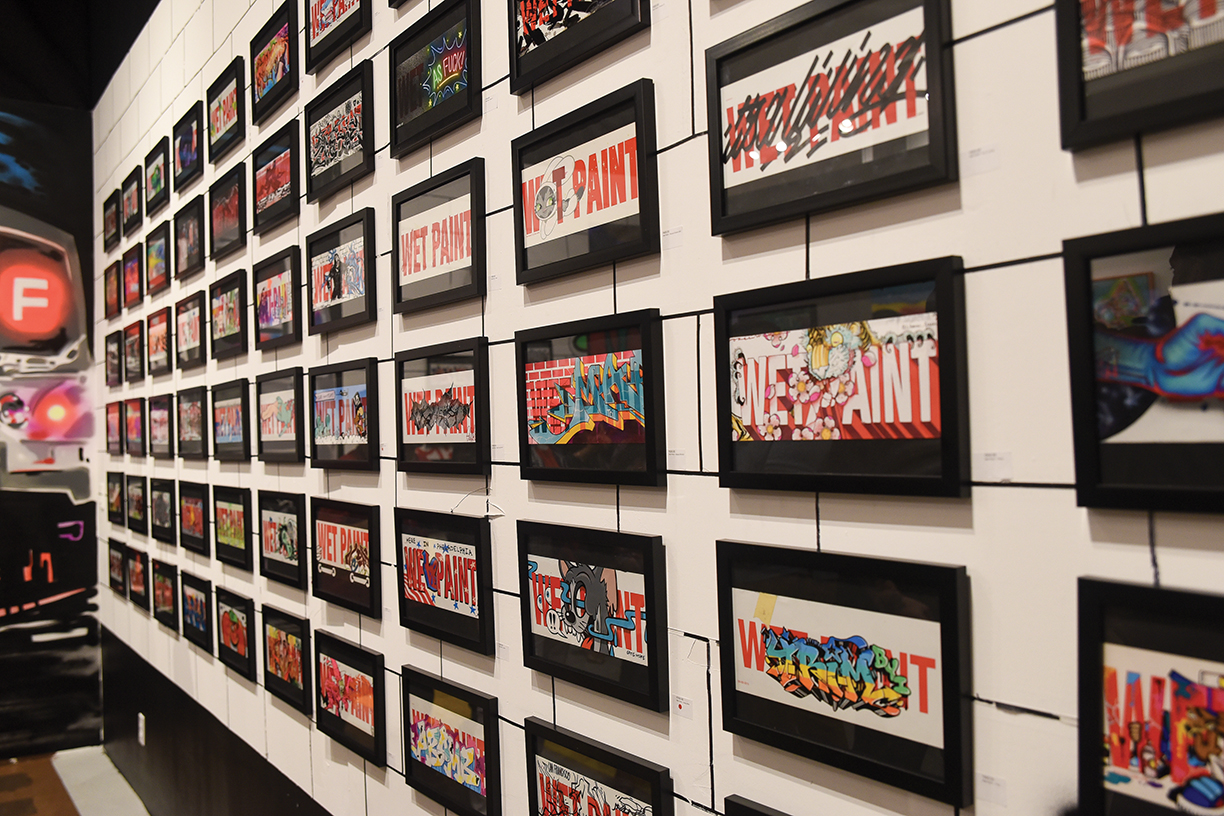
Above: The “Wet Paint” exhibit at the Museum of Graffiti in Miami, from artist Persue. Photo courtesy Museum of Graffiti.
At Right: “Party Felix” by Seen, one of many artists showcased at L.A.’s Mayfair Hotel. Photo courtesy the Mayfair Hotel.
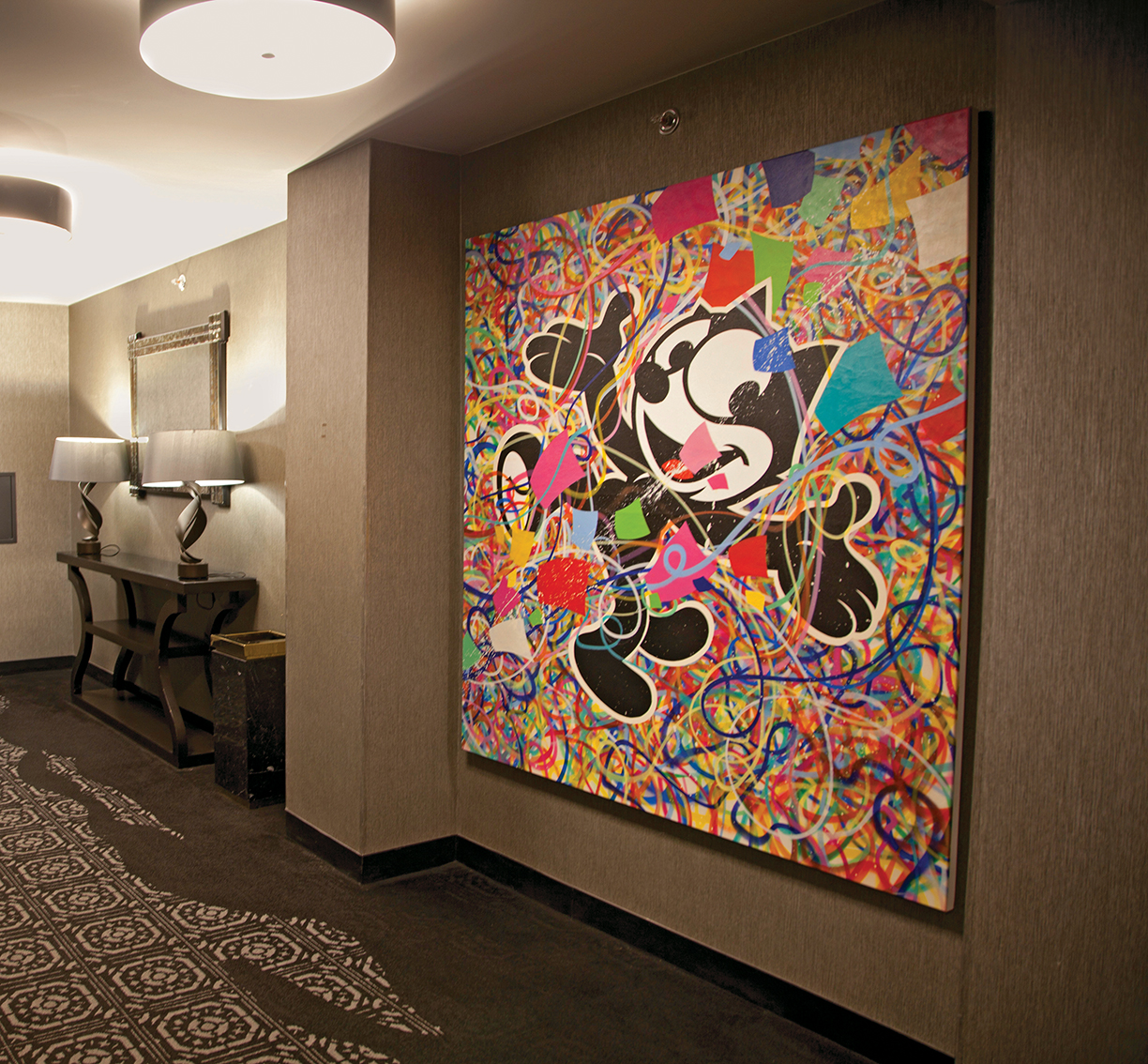
Explaining its location in a former shoe warehouse in Wynwood, Freidin reports, “The district’s relevance in the past 10 years is a product of the graffiti art that transformed a sleepy industrial neighborhood into the world-class arts destination it has become,” noting the windowless warehouses made ideal canvases for street artists. The Museum of Graffiti’s own building is entirely wrapped in 14 different murals by acclaimed local and international artists like Shoe, EZO and Abstrk.
The museum’s interior galleries feature rotating exhibits such as a recent compelling vignette from artist Persue, who famously removed the “Wet Paint” signs that New York City transit workers used to tape to subway cars after painting over graffiti art. Persue sent more than 70 of those very placards to artists around the world to use as canvases, all of which were incorporated into an exhibit whose physical design resembled a New York subway station platform.
Freidin explains that Miami’s graffiti art movement began in the early 1980s when some youth who got into trouble in New York were sent to South Florida to live with grandmothers or aunts. Insisting there is no way to repress the energies of an artist, Freidin reports, “The art erupted like a vengeance.”
The museum co-founder applauds the success of local graffiti artists like José Parlá, whose work moved from the streets of Miami to a mural inside Manhattan’s One World Trade Center, as well as multiple museum exhibitions and commissions in Tokyo, London and Havana. “He was immensely talented and continued to put in the work despite the stigma associated with graffiti art as vandalism,” says Freidin, who adds, “He’s probably one of the biggest names in contemporary art in the world.”
It was not easy for some museum curators to persuade their boards of directors that people previously labeled as vandals should be showcased in world-class fine arts facilities, but Freidin maintains society has evolved. She offers the former criminalization of marijuana as an analogy, citing its progression from disdain to broad acceptance. “It takes forward-thinking arts enthusiasts to take a risk,” and reports major corporations are hiring these artists as creative directors. “They recognize the power of this art,” says Freidin.
Robert Michael Provenzano, professionally known as CES, is a leading graffiti stylist whose signature aesthetic is now influencing the generation of artists currently emerging from the streets. His art, which began almost 40 years ago in his native Bronx, repeatedly got him into trouble as a young man, but after being flown to Munich to demonstrate his craft at a museum he realized there was a market for his skills. “My friends and I used to have to steal supplies, but now I’m a sponsored artist by a paint company in Barcelona,” says CES of how attitudes toward graffiti art have changed.
CES has since earned commissions from Nike and Palms Casino Resort in Las Vegas, in addition to collaborating on a mural adjacent to Miami’s Museum of Graffiti, where he was recently headlined. He finds it ironic that the artistic expression that was so strongly discouraged when he was a teenager is now a source of pride for his family. “I had no idea that if I stuck with it all those years, the whole world was gonna dig it,” reports CES.
The High Museum’s Michael Rooks notes, “The migration of some graf artists into the mainstream via museum collections and exhibitions underscores a familiarity with the language of the street that is widely recognized among urban audiences, as well as the influential role it has on global visual culture today.” He adds, “A fulcrum point in the migration from the street to the museum has to do with an artist’s knowledge and understanding of this legacy and ability to speak with urgency and artistry to contemporaneity.”
The ultimate measure of acceptance of art is the monetary value it commands in the marketplace. In 2017, an untitled work of Jean-Michel Basquiat, who began his career spray-painting walls in Lower Manhattan, sold for $110.5 million to a Japanese billionaire at auction, eclipsing his own personal record of $57.3 million.

Known as the King of Pop Art, L.A.-based artist Nelson De La Nuez is one of the most sought-after pop artists working today. His work is regularly exhibited at prestigious art fairs, such as Art Basel Miami and Art Central Hong Kong, as well as promoted through partnerships and private collections, including a series of works for Warner Bros. to commemorate The Wizard of Oz’s 70th anniversary.
In an interview with De La Nuez, he discusses how the incorporation of images from American pop culture, today’s advertising, high-end branding and more have strongly influenced his artwork since the 1980s.
What kind of memories do you have from your childhood?
I was born in Havana and I came here to Southern California when I was seven years old, started first grade here. I still remember Havana, which I can remember back to when I was three years old. I took it all in. Fond memories of going to the beach, riding my bicycle around the neighborhood, doodling in the backyard.
How did your childhood affect you later on as a person, as an artist?
Well I’ve always been an artist, ever since I can remember. That kind of kept me entertained for hours, I would always get lost with [my art]. I love sports, but art has always been there for me. It was my escape. It was just a way to get away from everything.
Do you still use art to get away, now that it’s your career?
I’m always thinking 24/7 about what I am I gonna do, about ideas — so what I do is I jump on and go motorcycle riding and that kind of helps me come back again and revisit a piece or an idea, and look at something differently. What I was looking at a half hour ago looks different now, since I’m in a different state of consciousness, and I get to relax.
Material Girl

The Good Life
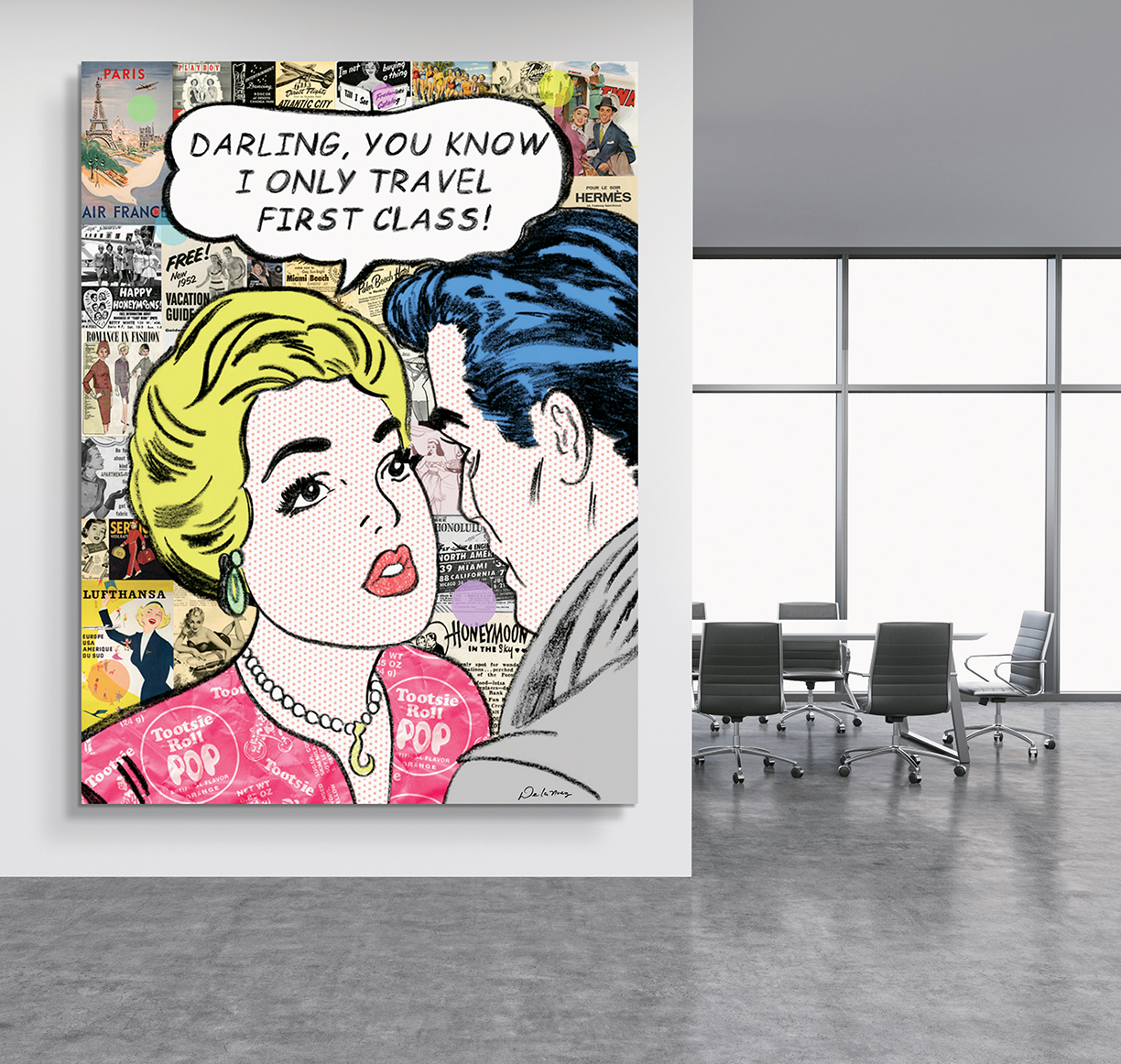
What kind of themes do you see from your childhood that are presented in your art now?
Most of what I do today is rooted in American themes from my childhood. I remember coming here [to America] and I remember seeing on TV the first Superman, TV commercials, the mascots — it all just spoke to me and I just absorbed it like a sponge.
How did these themes develop into your style?
The reason why I’m doing pop art is because of everything I observed early on when I came to this country. Living in
California is like living in a fantasy land when you come from a different country. There’s billboards, commercials, advertising, and you never know where the ideas come from. When I really think back, a lot of what I do today is really a reflection of what I was thinking and experienced when I was a kid.
Aside from your childhood, are there trends or present-day themes that inspire you?
I’m inspired by everything, literally. Every mundane object that you could think of I will look and see something there that I can maybe create into a piece of artwork. Whether it’s a billboard or a magazine ad, or an elusive train [of thought] I had the day before, I’ll ride it all the way down. I am really a byproduct of everything I’ve observed or experienced in my entire life. So I have this database in my subconscious where I can draw from.… Everything is art for me. It doesn’t necessarily need to be hanging on a wall, it could be fashion, it could be a song; everything is just an inspiration.
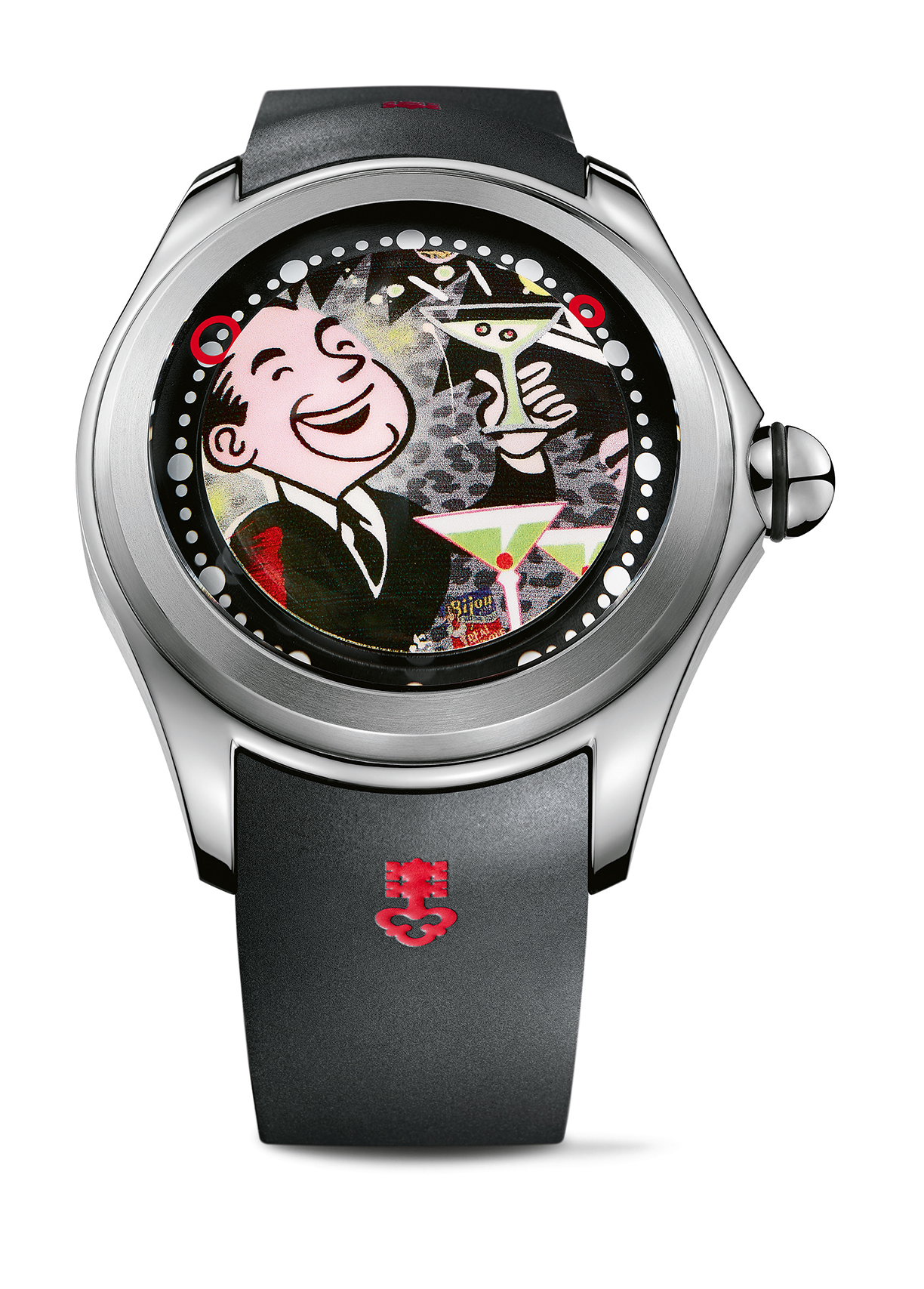
Corum Bubble Martini Watch
How does your art coincide with the clientele you usually work with?
Each partnership that I’ve done is
different, basically all with high-end brands. Each of them is unique and different; I just love working with high-end brands because it just puts my art on a different level and exposes me to a lot more people. Basically it provides a plateau to take my work to the next level and having the audience take a look at my work in a different way. That’s my audience, it’s always been a very well cultured, well traveled group that love high-end brands. It’s an audience that know what they want and how to express themselves, and they do that with my art.
What do you like most when people view your art in various forms?
I love when people react immediately. That kind of gives me a great deal of comfort. You put in all this energy and hard work and you don’t know what to expect. And they usually say “Yes, that’s the painting for me,” because it’s got legs, it speaks not just to them, but to a mass audience — it makes them happy, makes them smile, sometimes it makes them laugh. They know the perfect place that they want this for in their home. Some of them are drawn to a specific piece for no reason at all; they just relate to it.
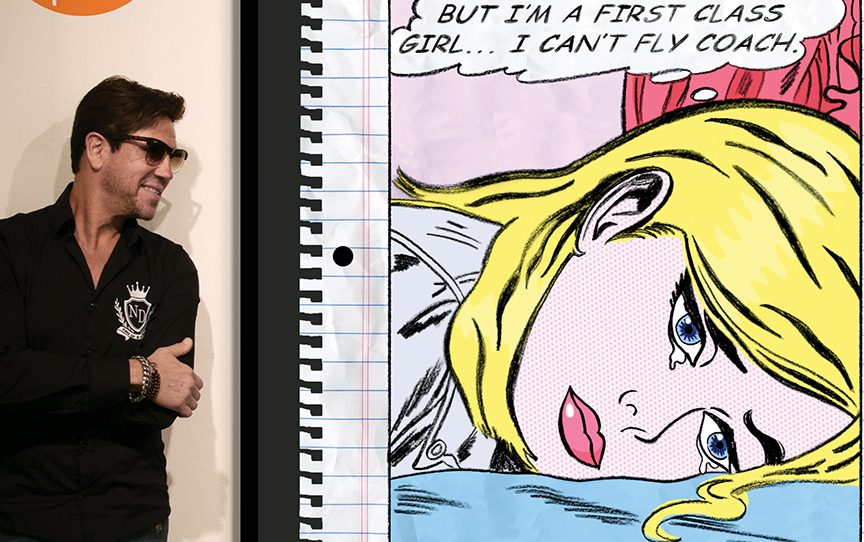

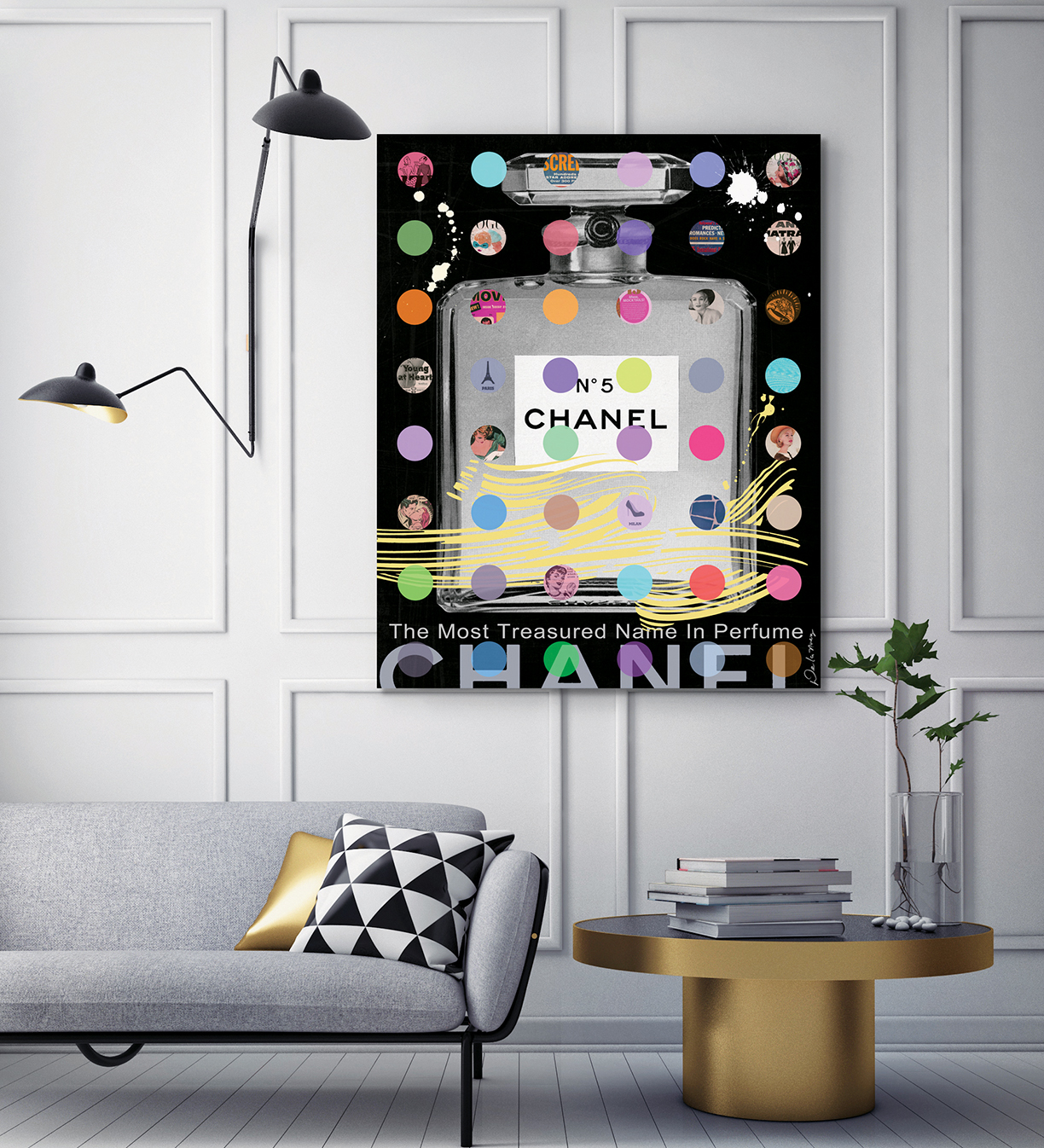
Upper Left: First Class Girl – LA Art Show 2019
Bottom Left: High Maintenance (Left) and Yacht Life (Right)
Above: Chanel No. 5 (Black)
What’s a project you’d love to work on in the future?
I would love to design something like an entire hotel design, the colors, the furniture, the wallpaper. The other thing that I would really love to do is work with a cruise ship to design their rooms, or design the entire ship using my art. That’s kind of what I get excited about most, getting to do [art] on a large massive level, where it’s not just a small project, but a huge undertaking, to take it to another level.
Any advice for aspiring artists?
The number one piece of advice I can give is that you have to be committed to your craft. You need to find out who you are and what message you want to put out into the world, then you have to be good enough and clever enough and have something unique and different. You can’t just be a part-time artist, you have to do it full time and it takes a while.… Good art is subjective, but when you have people paying sometimes hundreds of thousands of dollars for your art, you know that you’ve done something right.

Property by Myra Nourmand
310-888-3333
Live amongst the captivating properties of Beverly Glen with its beautiful tree-lined canopies and expansive flat lots. This beautifully appointed home is absolutely breathtaking! The entire property opens to the enormous yard, which is totally private and quiet, embracing the ideal of indoor-outdoor living. Soaring ceilings, floor-to-ceiling windows and an open floor plan, the home has a light and airy feel. Flexible layout features 4 bedrooms upstairs, one large bedroom suite downstairs, office and attached 2-room guest house. Top-of-the-line appliances such as Miele, Viking, Sub-Zero, Fleetwood, and NeoRest. Perfect for outdoor entertaining with the cozy loggia and fireplace, built-in BBQ and saltwater swiming pool and spa. Even solar, making this 7,000-plus-square-foot property almost off the grid! Enjoy the 3-car garage, spectacular 500-plus-bottle wine cellar, Crestron, fully secure, elevator-ready. A fantastic opportunity for an exceptional home in most desirable Warner Elementary school location.







Stacy Gottula, one of the premier luxury real estate brokers with the Agency, a firm located in Beverly Hills, has officially redirected her career toward working with the Eklund and Gomes team associated with Douglas Elliman.
This is just three months after the Eklund-Gomes team expanded into Los Angeles, where Frederik Eklund, the long-time star of the hit TV series “Million Dollar Listing New York,” moved in order to dominate the West Coast.
“I’ve been chasing her and we’ve been talking for a long time,” he said of Gottula to The Real Deal. “What she’s bringing, which is something I really need at this point is the experience pitching big, big listings.”
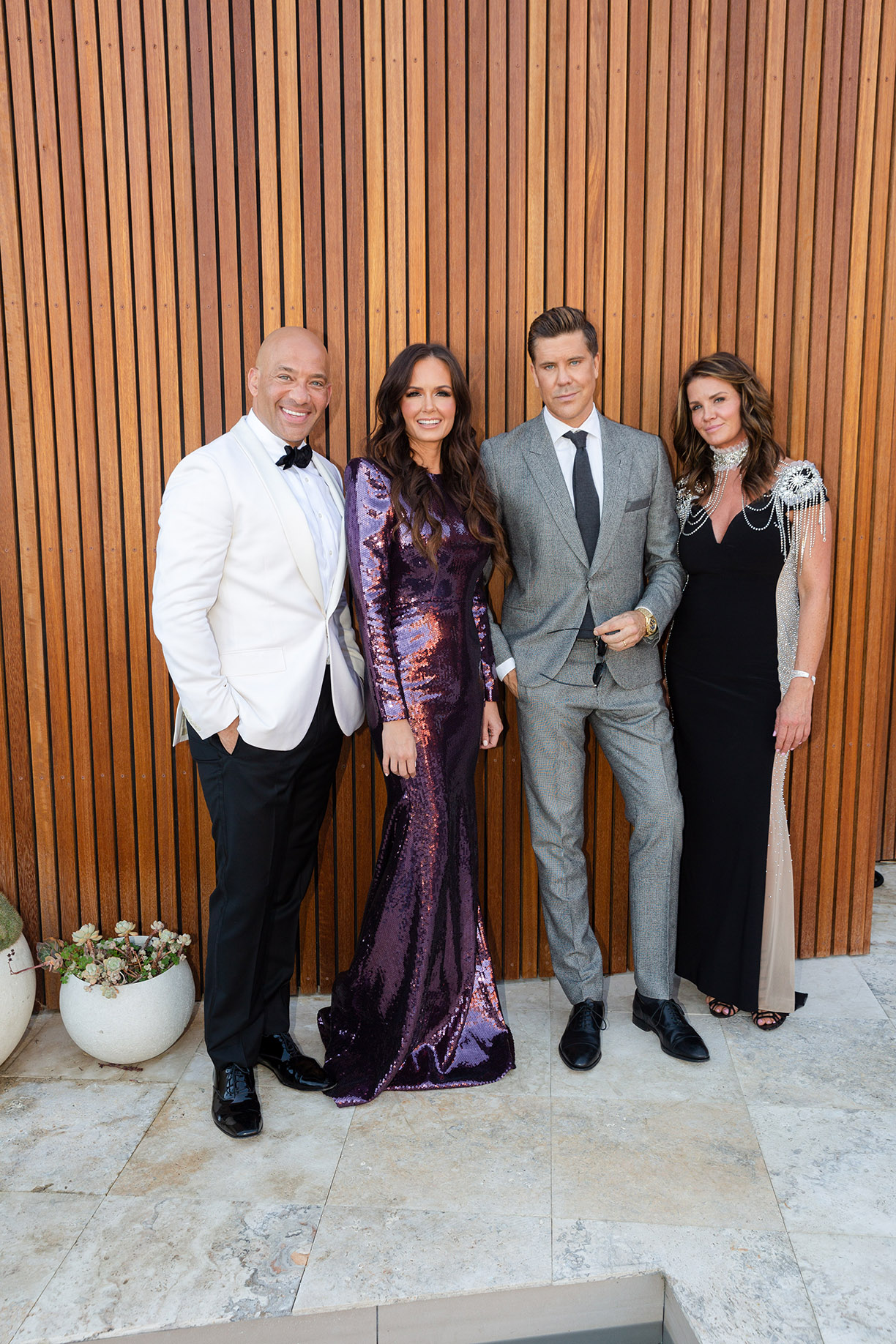
Photo courtesy of Tigran Tovmasyan, One Sixty Studios
Gottula credits her decision to transfer onto the Eklund-Gomes to wanting to work in a team atmosphere again. At the Agency, she worked solo on most projects — and she told The Real Deal that after seeing the team at Douglas Elliman, “it felt right.”
This is another big hit for the Agency, as Stacy Gottula brings the firms’ lost brokers to a count of 45 in Los Angeles.
Los Angeles’ crescent-shaped Century Plaza Hotel was built in 1966 — hardly historic vintage by European (or even East Coast) standards — but with its significant role in the entertainment industry and presidential politics, the iconic building is a bona fide landmark. Local preservationists saved it from the wrecking ball, and now it is being reimagined as part of an ambitious
$2.5 billion project.
The 19-story midcentury hotel was originally designed by Minoru Yamasaki, the renowned architect for Manhattan’s now-defunct World Trade Center as well as a familiar pair of twin towers in Century City. The Century Plaza will be reopened as the Fairmont Century Plaza Hotel & Residences, a new jewel in entertainment industry-saturated Century City.
Behind the 400-room hotel will soar a pair of 44-story high-rises accommodating some of L.A.’s most luxurious condominium residences, an homage to Yamasaki’s penchant for twin towers. The project, a venture of Next Century Partners, with primary funding from Century City-based Woodridge Capital Partners, reflects an ongoing renaissance of Century City, which was originally developed on the back lot of 20th Century
Fox studios.
Mary Ann Osborn, Managing Director of Sales & Marketing for the Century Plaza Residences, indicates Century City is evolving into a more 24-hour, walkable neighborhood. “We’re receiving considerable interest from people who work in Century City, so they have an opportunity to walk to work, which is quite a rarity in L.A.,”
she reports.
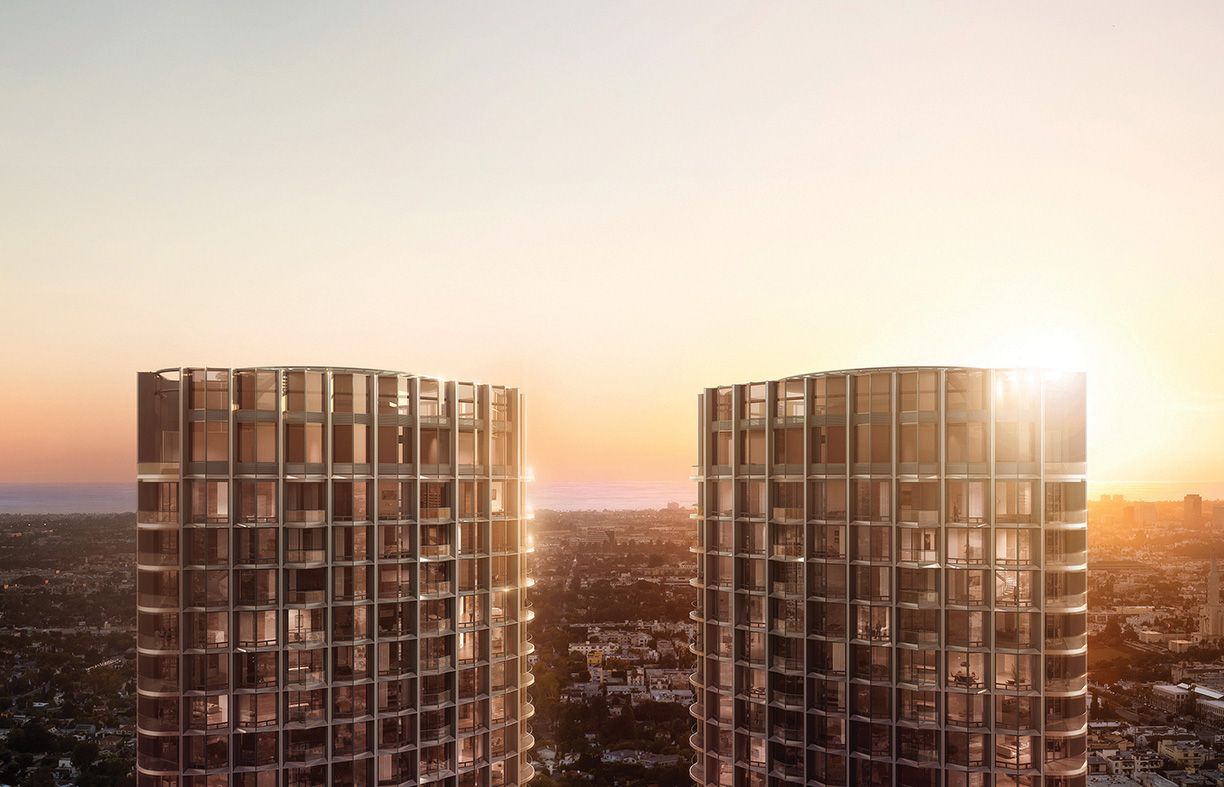
A total of 268 residences will be accommodated in the two towers rising above the hotel. Condominiums in the north tower are currently being marketed, ranging from a 962-square-foot unit priced at $1.7 million to a 3,954-square-foot (3-bedroom/4.5-bath) condo on the 35th floor offered at $10.8 million. Floor-to-ceiling windows provide panoramic views from Hollywood to the Pacific Ocean, while generous glass-railed balconies capitalize on L.A.’s signature indoor-outdoor lifestyle. “Many buyers are downsizing from large homes in the area, but still demand the amenities of a luxury estate property,” says Osborn, who adds, “They want a lock-and-leave lifestyle with every need taken care of.”
The amenity package for the tower residences includes fully-staffed health-and-wellness facilities, children’s playroom, business center, screening room, game room with bar, wine lockers, and dining rooms. Also provided is an outdoor swimming pool, gardens that encompass a yoga/meditation lawn, dining terrace and dog park. Occupancy for the north tower is anticipated in the fourth quarter of 2020.
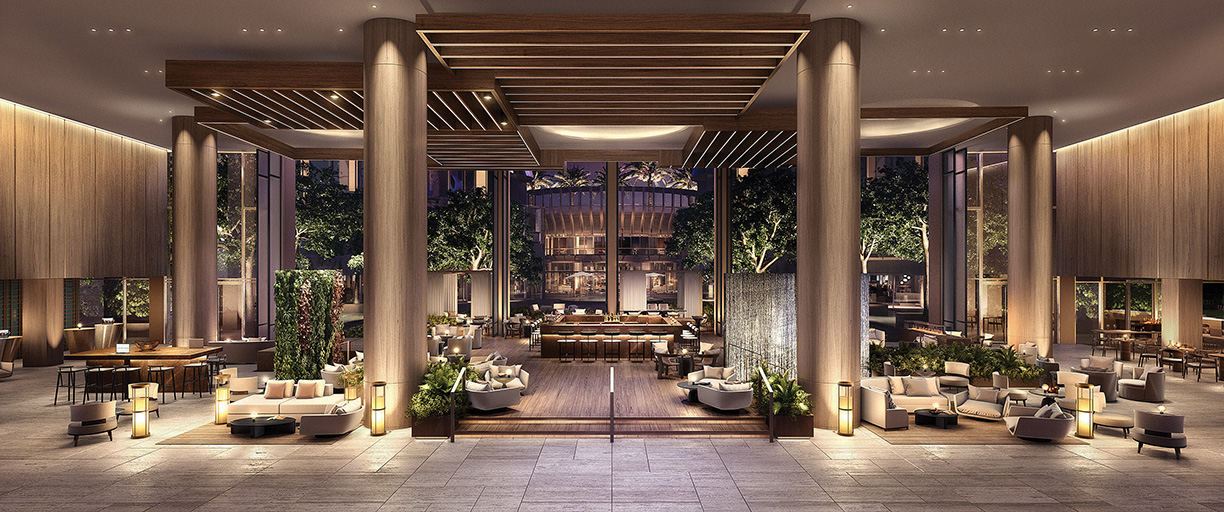
Hotel’s grand lobby.
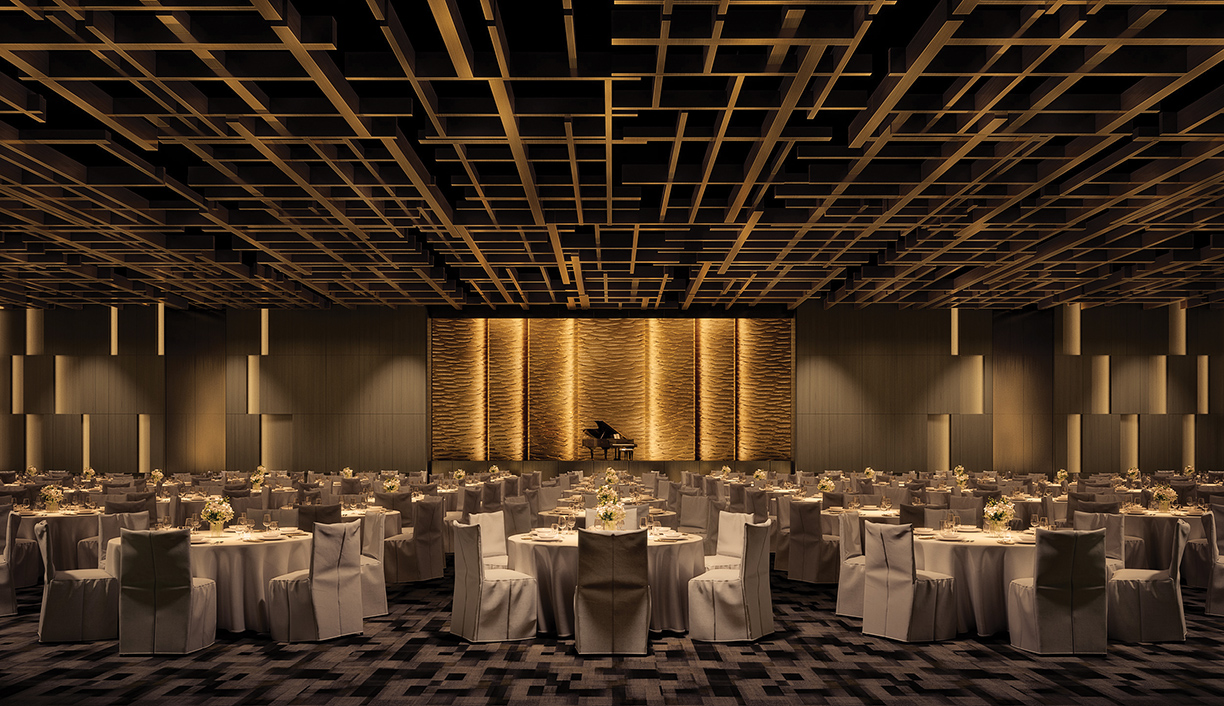
Exclusive event venue.
The new Fairmont Century Plaza Hotel transforms a landmark for a new generation but recaptures the glamour of the former hotel, popular with celebrities and heads of state. The original architecture, a 20th century style known as New Formalism, is generally being retained by the new design team, but modernized both aesthetically and functionally.
Three acclaimed architectural firms — New York-based Pei Cobb Freed & Partners and L.A.-based Gensler and Marmol Radziner — are collaborating on the project along with international luxury hotel interior designers Yabu Pushelberg. Entrance to the hotel will be through a plaza anchored by a large-scale, interactive sculpture by celebrated Spanish artist Jaume Plensa and refreshed by water features.
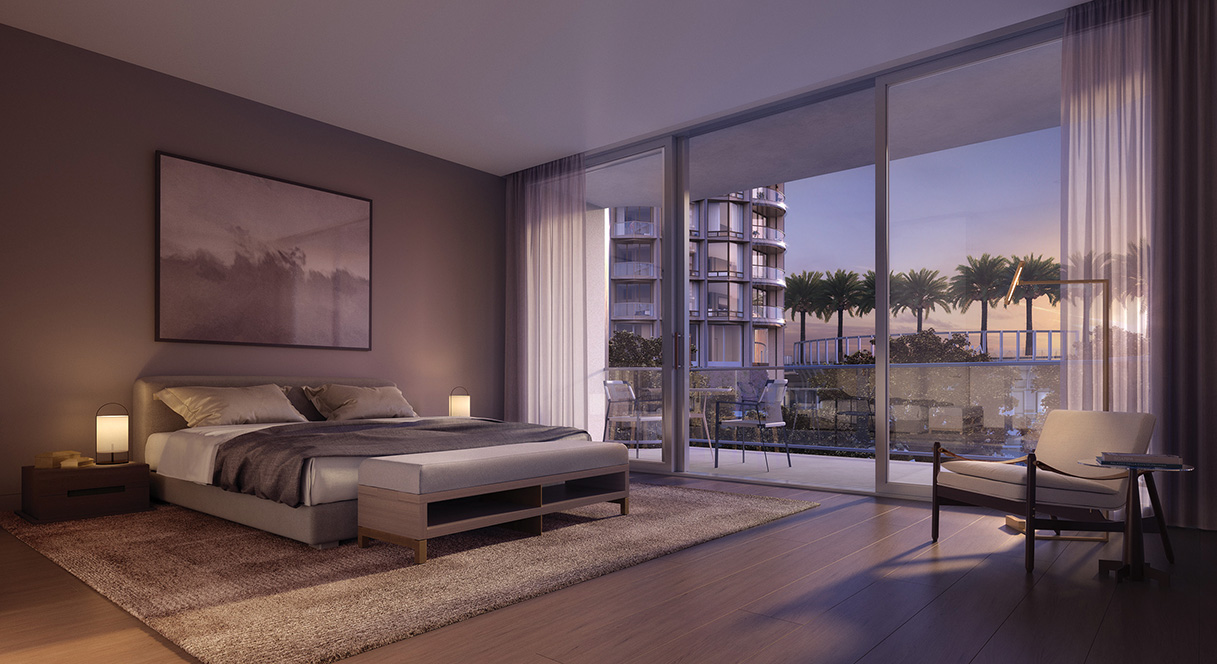
Bedroom at Fairmont Residences.
In addition to the tower residences, 63 Fairmont-branded luxury residences are offered in the new hotel, available for occupancy in the fourth quarter of 2019. The Fairmont Residences, accessed through a 24-hour security gate leading to a private building entry and dedicated elevators, will enjoy the services of a five-star hotel and privileges at all of its facilities. Currently offered at the Fairmont is a 2,550-square-foot unit at $5.7 million, while a one-bedroom, 1,539-square-foot condominium is priced at $3.232 million.
Homeowners at the Fairmont Century Plaza will appreciate state-of-the-art technology while residing in an iconic, historic hotel that represents the very essence of the Century City lifestyle. Each of the hotel residences reflects a blend of classicism and modernism, with usable terraces blurring the lines between indoors and out. These units represent ideal pieds-à-terre for international entrepreneurs, professional athletes or entertainment industry executives who insist on privacy and convenience, along with a subtle dose of Hollywood glamour.
Century City, overshadowed by Beverly Hills and West Hollywood a decade ago, has reemerged as one of the hottest luxury markets in L.A., and this Century Plaza development is occurring during an impressive renaissance of the district. The neighboring Westfield Century City shopping center recently completed a $1 billion renovation, making the venue a regional attraction for high-end boutiques, restaurants and entertainment.
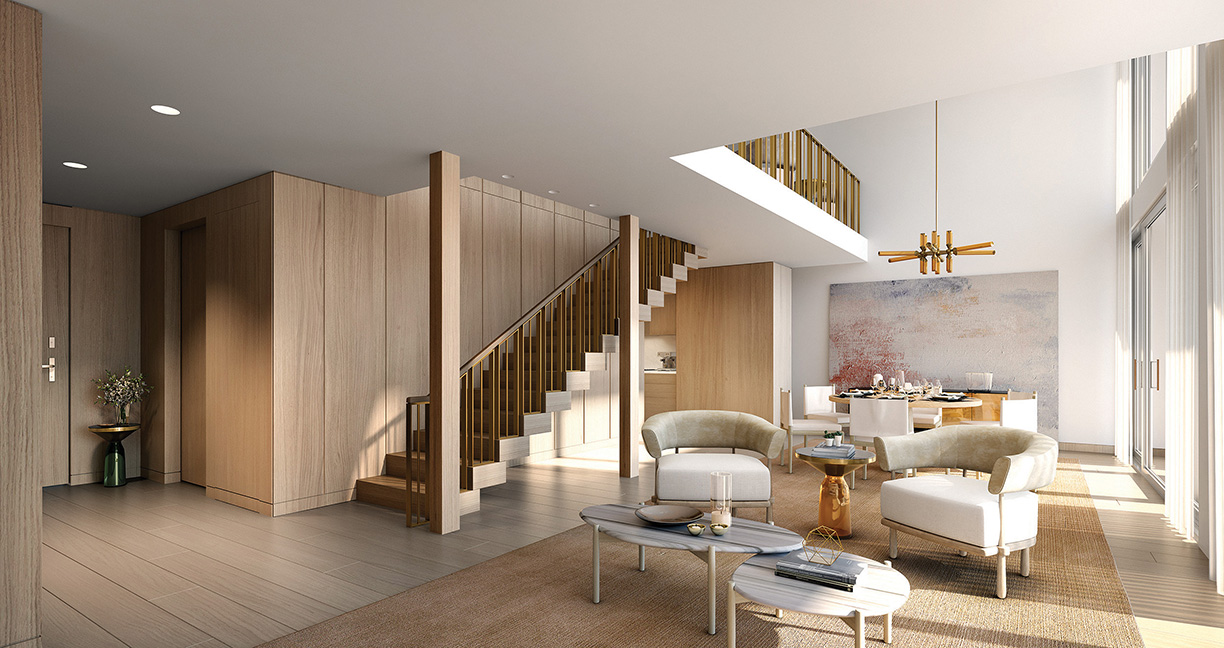
Fairmont Residences duplex.
Osborn notes that an additional 100,000 square feet of retail space incorporated into the project will further ensure a 24-hour, amenity-rich experience, and that Century Plaza Residences is responding to Angelenos’ newfound appreciation for vertical living. Osborn also reports considerable interest from international buyers, both European and Asian, who are familiar with Century City through business or know it from shopping in adjoining Beverly Hills.
The Fairmont Century Plaza Hotel and Century Residences, with units commanding more than $2,700 per square foot, demonstrates confidence in the luxury housing market and overall economy of both Century City and Greater L.A.
Renderings courtesy of DBOX.
REAL ESTATE EXECUTIVE TAMI HALTON PARDEE IS COMMITTED TO GIVING BACK, EMPOWERING THOSE WHO HAVE NO ROOF AT ALL.
Founder and CEO of Halton Pardee + Partners, Tami Halton Pardee is one of the nation’s premier real estate entrepreneurs, leading her Los Angeles-based firm to sell more than $3.8 billion worth of properties since its inception in 2004. Halton Pardee is also a prominent philanthropist who created the Life Change Warriors foundation in 2017 after years of promoting a culture of giving at her company.
In 2001 Halton Pardee was diagnosed with multiple sclerosis (MS), a devastating blow to a vibrant young woman just entering her thirties, but she drew inspiration and energy from this adversity. “That call from my doctor taught me I had to start planning my life, not just letting it happen,” recounts Halton Pardee, who adds, “I needed to start living my best life.”
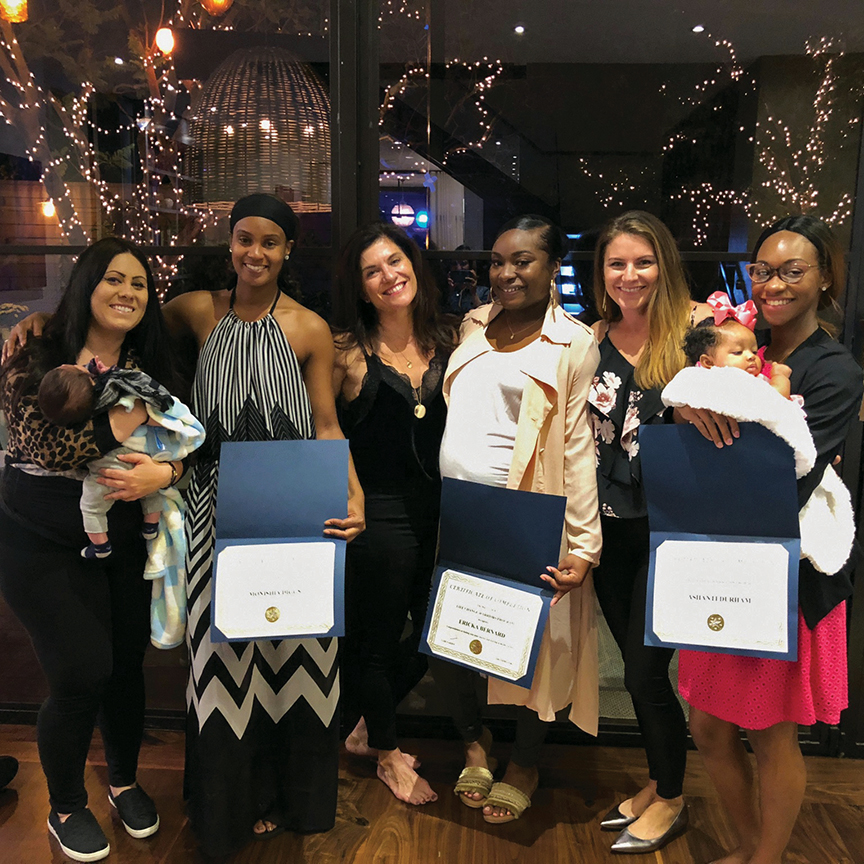
Photo courtesy of Halton Pardee + Partners.
Halton Pardee founded Life Change Warriors to help people move beyond their own traumas, whatever those may be, and as a real estate professional and mother of four she focused her attention on homeless women and at-risk kids. The real estate executive had always been committed to returning some of her good fortune to the community, and Halton Pardee + Partners maintains a policy of donating a portion of all commissions to local charities, totaling more than $1.3 million over 14 years. But with her newfound sense of purpose, Halton Pardee yearned to be more hands-on in her giving, and those charitable proceeds are now directed primarily to Life Change Warriors.
The foundation translates Halton Pardee’s long-held philosophy of creating one’s best life through human connections, but presents it through a more structured methodology. Life Change Warriors offers six weeks of classes — she teaches them herself along with two life coaches — for people unable to get beyond their respective traumas, often relegated to living on the streets.
“Everybody lives in the past and believes that it dictates their future, but it doesn’t have to be that way,” insists the entrepreneur, who personally overcame her own traumas. “I want them to live their best lives,” reports Halton Pardee, who hosts students at her home for graduation dinners. The graduates receive a monetary gift to use as a deposit for an apartment or to pursue a degree or career goal, finally breaking the cycle of homelessness with a newfound sense of empowerment.
One of Life Change Warriors’ many success stories was a single, homeless mother named Sylvia, who after graduation from her six-week class went on to receive her high school equivalency certificate and was placed by the foundation in a job with a nonprofit affordable housing developer, where she has since been promoted to property manager.
“After selling a $10 million home, how can any agent not think of giving a portion of that commission to people who don’t even have a roof over their heads?” asks Halton Pardee, who notes the real estate industry is ideally suited to this kind of charity. “When you believe in someone, it can really change their life,” she says, noting that until many of her students begin classes, they have never before had anybody truly believe in them. “They need to know they’re worthy and that there’s a way out of homelessness, that they can escape whatever happened in their past,” explains the inspiring philanthropist.
Usually, it’s possible to sum up the outlook with a pithy phrase, but this year the luxury landscape is nuanced. Some markets sizzle; others simmer. Dynamic outside forces are at play and will potentially exert even more influence in 2019. In the background, the words recession and bubble are whispered, but most experts don’t see either in the cards, particularly for residential real estate in 2019.
“In most markets, I think it’s a case of ‘from great to good,’” says Stephanie Anton, president of Luxury Portfolio International.
“We’ve left a crazy market, and we’re moving into a more normal market,” shares John Brian Losh, chairman of Who’s Who in Luxury Real Estate. “We are beginning to see a more normalized market where supply is more equal to demand. Even in the luxury market, there are fewer bidding situations.”
According to Redfin, the number of competitive offers fell from 45 percent to 32 percent in 2018. Still, some ZIP codes in busy markets such as Boston, Washington, D.C., and the Bay Area remain hotbeds of competition, with the number of multi-bid scenarios increasing in the third quarter.

© istockphoto.com/JZHUK
Concerns about potential bubbles continue to percolate, but economists and other experts caution that fundamentals are strong and for real estate the next downturn will be different. “The recent tax reform and increased government spending have been a shot in the arm of the U.S. economy,” Tim Wang, head of investment research at Clarion Partners, explained to journalists at the Urban Land Institute’s fall conference. Wang and other experts expect the current expansion of the economy to continue through 2019, tapering to 2.5 percent next year.
“The housing market is following the trend in the overall economy, which needs to be noted because housing led the last downturn,” comments Marci Rossell, chief economist for Leading Real Estate Companies of the World, citing politics and global uncertainty as factors affecting real estate. This time, she says, “the casualties will be a little bit different, and because of that I don’t anticipate a meltdown.”
A cooling period is how Craig Hogan, vice president of luxury at Coldwell Banker Real Estate, characterizes the luxury climate, particularly in the second half of 2018. It’s a change Coldwell Banker has anticipated. “For any of us to think it was always going to be incredible is a little naive. The market is always going to fluctuate.” Hogan says it’s important not to interpret cooling as a market decline. “Cooling is a normal fluctuation, while a decline happens when the value of homes begins dipping.”
“There hasn’t been any great price suppression. Houses are staying on the market a little longer, but demand is still healthy,” says Losh.
“I think we’re still going to have a very strong year overall. I do believe we’re seeing price adjustments, and that’s okay. I think the key is watching how long properties are staying on the market and watching the size of the price adjustments,” observes Lesli Akers, president of Keller Williams Luxury International.
The average sales price for Sotheby’s transactions is up year over year. “From a luxury point of view, many of our companies are having a record year,” says Philip White, president and CEO of Sotheby’s International Realty. “Revenues are up, and in some cases pretty significantly,” he shares, noting that this number also reflects significant recruiting and/or acquisitions by some companies.
Recent stats show prices for upscale properties still increasing, but at a slower pace than past years. The number of sales in many places has dipped, but that differs by location, and in more than a few instances sales still exceed 2017.
Data from the Institute for Luxury Home Marketing (ILHM) shows median prices for single family luxury homes climbing 8.5 percent in November over October, while the number of sales fell 11.7 percent. For attached luxury properties, sales rose 2.6 percent with a 2.3 percent hike in prices.
Putting the current market for real estate overall into perspective, Lawrence Yun, chief economist for the National Association of Realtors, said, “2017 was the best year for home sales in 10 years, and 2018 is only down 1.5 percent year to date. Statistically, it is a mild twinge in the data and a very mild adjustment compared to the long-term growth we’ve been experiencing over the past few years.” Yun and other housing economists are quick to point out that new construction still hasn’t caught up with demand and foreclosure levels are at historic lows, factors which make the current climate different than the run up to the recession. NAR’s forecast calls for an overall price increase of about 3 percent in 2019 while the number of sales flattens or edges up very slightly.
Tale of Two Markets
Luxury’s story is a little different. “This year the luxury market has been a tale of two markets, for sure. Some areas are struggling, but most have been stronger than many realize, particularly in the first half of the year. As median prices have been slowing (and getting lots of media attention), the top 5 percent of many major metro markets nationally have been growing, with sales over $1 million up over 5 percent year over year and prices breaking records, in some cases by double digits. In the majority of markets, inventory has been selling faster. This is happening simply because of the health of the affluent,” observes Anton.
What sets this year’s outlook apart is that some places are having a strong, dynamic market, while others are seeing a softening, often only in specific price brackets. “The slowdown that started on the East Coast is having some effect on the West Coast. But it’s not a typical slowdown,” says Mike Leipart, managing partner of new development at The Agency. “Good product that has relative value is continuing to transact.”
The top three sales nationally in the third quarter, each over $30 million, occurred in Laguna, and seven out of the top 10 were in Southern California.
Rather than a general market malaise, Leipart characterizes the slowdown as more of a spec home problem. “It’s just too much has been built too fast, and not all of it is very good. The people who thought they could build a house for $15 million and sell it for $30 million are struggling.”
The higher price points in L.A. may see an even stronger downturn in the near future, suggests Bob Hurtwitz, owner of Hurwitz James Company, who typically works in the very high end. “There is a lot of inventory on the higher end, and luxury home buyers are usually in a position to wait and see. The drops in price are a lot more dramatic on property at $15 million and above, and buyers are aware of the benefit in waiting to see how it plays out. At the ultra-high end of $100 million or more, you are going to see and already are seeing huge reductions in price.” What’s hot in L.A.? Luxury penthouses in full 24-hour security buildings in prime areas, according to Hurwitz. “High-end penthouses will continue to be in-demand from foreign buyers purchasing as a part time home or for housing for their children.” Other price brackets, notably the $1.5-million to $3.5-million range, are busy, and, Hurwitz says, his agents are doing a lot of deals.
Perceptions of prices in Manhattan can be skewed, since recent closings are often for new construction for which contracts (and prices) were written a couple of years prior. Even though stats show sales decreasing, Ellie Johnson, president of Berkshire Hathaway HomeServices New York Properties, says, “There is still a healthy but steady group of buyers that are still out there in the high-end luxury landscape.” Additionally, New York is particularly keyed to Wall Street, and volatility in the stock market often means more money gets transferred into brick and mortar. “We’ve seen an uptick that we didn’t have at the beginning of the fall season,” Johnson observes. Despite a less than stellar real estate market at year end, New York remains a global gateway and the top city for global wealth.

Manhattan
© istockphoto.com/CreativeImages1900

Los Angeles
© istockphoto.com/SeanPavonePhoto

St. Petersburg
© istockphoto.com/SeanPavonePhoto
In other locations, particularly those with lower prices for upscale properties compared to California, Florida or New York, reports show strong interest and price growth. An acre in one of Atlanta’s prime addresses in Buckhead can demand as much as $1 million. It’s just one indication that luxury here continues to reach new price levels with considerable demand coming from outside the region, including buyers from California and Florida. Some relocate simply because they want a home in the city; others follow corporate moves. The city has also become a favorite for the film industry, which has become a $4 million industry. “It’s changing everything about this city,” says Debra Johnston with Berkshire Hathaway HomeServices Georgia Properties. Luxury really doesn’t begin until the $5 million threshold, says Johnston, but prices compared to Florida and California are reasonable.
At one time, it was thought it might take more than 20 years for Florida real estate to recoup from the recession. In October, the state tracked 82 consecutive months of price hikes for both single-family and condo-townhouse properties, with many cities showing double-digit increases in the number of sales. “The overall market in Florida, particularly higher-end areas such as Sarasota, Naples and Palm Beach, is definitely strong and stable. Maybe not as robust as say 2013 and 2014, but we haven’t had any major slide — except the economists talking about the market slowing down,” says Pam Charron with Berkshire Hathaway HomeServices Florida Realty in Sarasota.
“The St. Petersburg market seems to be performing differently than other Florida markets and other national trends,” observes Tami Simms with Coastal Properties Group, noting November sales skyrocketed over the prior year. “We have developed into a year-round market with luxury downtown condominiums in high steady demand.” Another sign of consumer confidence is lack of defaults on pre-construction sales. “When we experienced the crash, those buildings that had been sold out prior to completion experienced a significant number of defaults. We see none of that in this instance.”
Florida is one of several states including Texas and Nevada benefiting from changes in tax law. Tax changes not only force some to reevaluate where they live, but they also impact the margins of price brackets. “While it doesn’t mean people wholesale leave New York or San Francisco, marginal changes tickle up and trickle down to the next closest price level,” and it will take several years for that to be felt, says Rossell.
The New Market
“So many trends have taken place they are no longer trends, they are the new market,” observes Hogan, using new construction as one example. “It doesn’t matter where you go or who you talk to, new construction is part of the conversation.”
Global demographics will have a long-term impact. “What luxury is adjusting to is a different demographic worldwide. Those aging baby boomers are kind of done with big homes and the following demographic is 50-percent smaller,” Rossell says.
Changing demographics affect location and property type. “I think we’ll see increased demand for primary residences in traditional second home and resort markets. We are seeing this trend in select markets, as individuals who have the freedom to work remotely are opting to live in places where they feel their quality of life will be the best,” observes Anthony Hitt, president and CEO, Engel & Völkers Americas.
Summer 2019 will mark the most prolonged economic recovery since World War II, but wild cards including interest rates, a trade war and further instability could easily derail this expectation. However, there is a silver lining to the current market. Increasing inventories will bring some buyers back to the market and create more demand. “I think it’s going to a be a great opportunity. People will buy things that they haven’t considered, and they’re going to buy more of them. I think that’s been a big challenge. We’ve not had the inventory, and a lot of buyers kind of just fell out of the market because they didn’t feel like there really was one,” explains Akers.
ILHM President Diane Hartley believes 2019 will be a year of opportunity for both buyers and sellers provided they remain agile, innovative and adaptable to their local market influence.
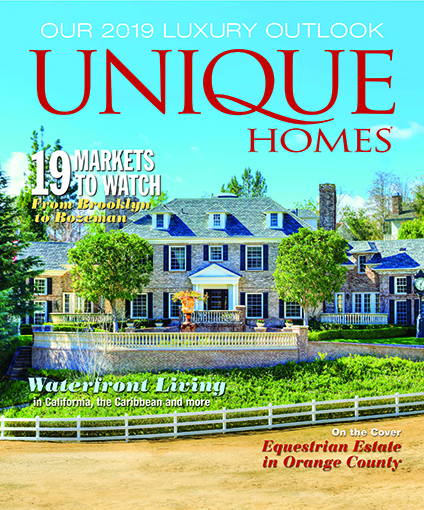
This story originally appeared in the Winter 2019 edition of Unique Homes Magazine.

Emerging from the exclusive realm of off-market listings, the recently listed The Mountain site is turning the heads of buyers, sellers and Realtors with its record-setting list price of $1 billion. Minutes from the Beverly Hills Hotel and Rodeo Drive, this 157-acre hilltop location has been transformed into the world’s most exclusive and private residential real estate compound.
The property, currently owned by Secured Capital Partners, was consolidated from 17 multiple parcels into “one large real estate diamond,” according to Ronald Richards, legal counsel and spokesperson for Secured Capital Partners. Aaron Kirman, president of Pacific Union International, Estates Division and the listing agent for The Mountain, affirms that no other property with these possibilities exists any place close to Beverly Hills. “This is the only opportunity to own your own mountain that looks down at all of Los Angeles. Our likely buyer for this property is an individual who wants to build his or her own compound,” says Kirman.
The compound is the size of a small city, with six parcels that are made ready to build and have unobstructed views that range from downtown Los Angeles to Catalina Island and Santa Monica. With the amount of space to fit the entirety of Disneyland, and 57 acres to spare, the buyer will be able to build three buildings up to 500,000 square feet and up to 53 feet high, with the nearest neighbor a half-mile away.
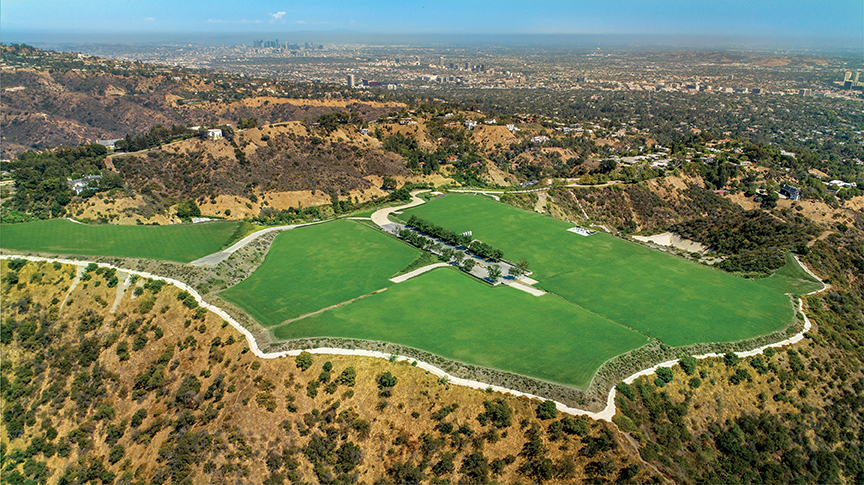
In order to perpetuate exclusivity, invaluable amounts of time and effort have been spent to make this one of the most private properties in the country. More than 500 trees and 5,000 smaller plants have been transplanted to the property, along with a massive 16-foot-tall custom security gate.
Other renovations made to the property were outfitted as preparations for development, but still leave the land open to suggestion. Stone aggregate roads lead to a hand-selected cobblestone drive, as well as a sculpture court accented by a full-length water feature. An in-depth landscape lighting design exists throughout the property, as well as a storm drain system, a booster system for fire hydrants and a backup generator.
“To be able to claim ownership of the largest property at the highest point in all Los Angeles, will make the buyer the most prestigious billionaire overnight,” says Richards.
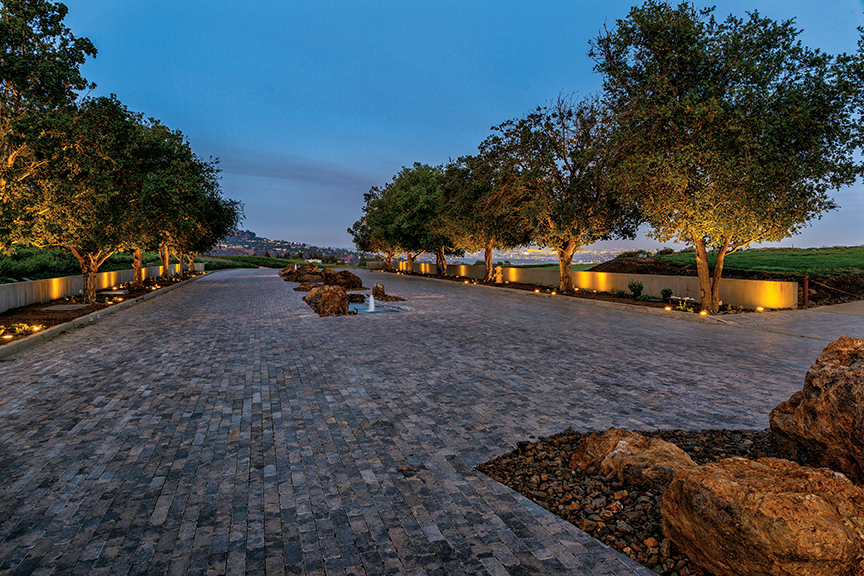
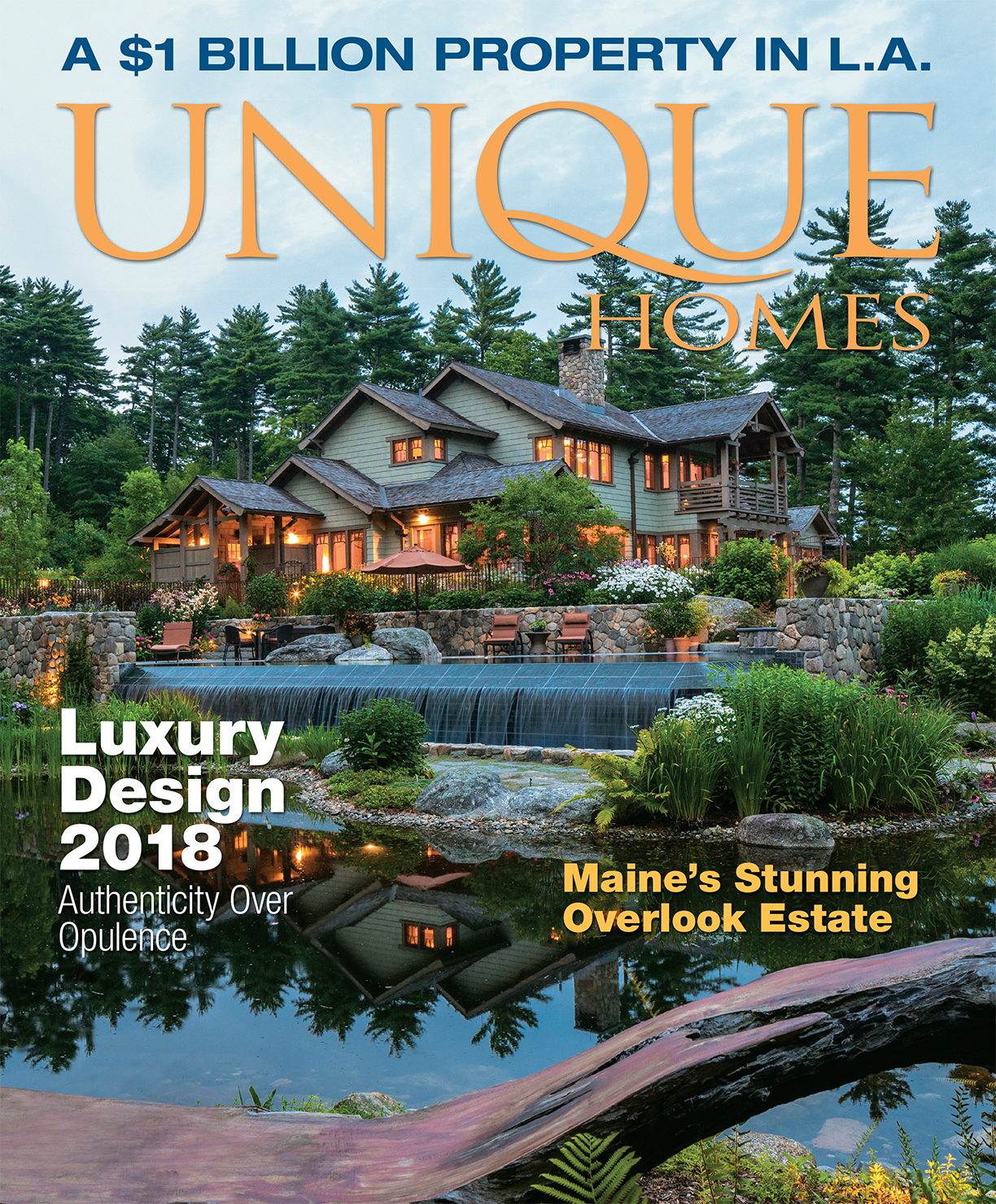
A glimpse at some of the finest Presidential Suites in the world reveals that some of the amenities in just one of them include: Cantilevered glass balconies, a breathtaking library with a 26-foot cathedral ceiling, a Bösendorfer baby grand piano, lacquered walls with inlaid mother-of-pearl detailing, world-class art and a master bath clad in rare Chinese onyx.
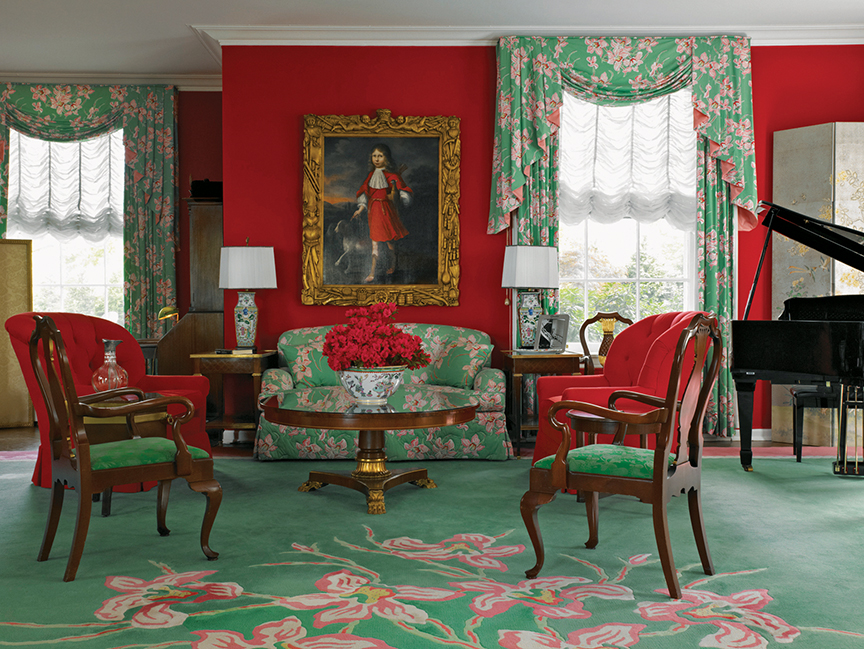
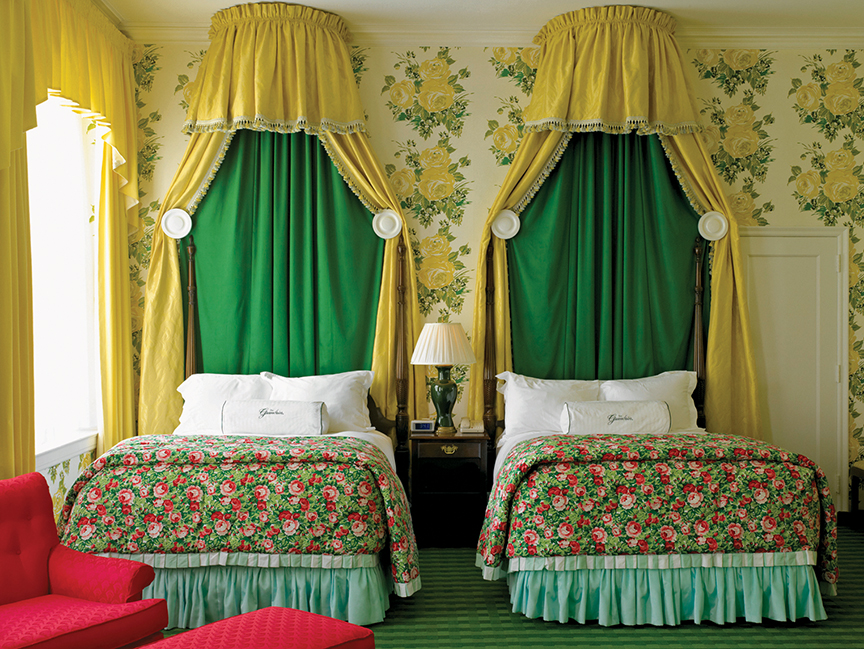
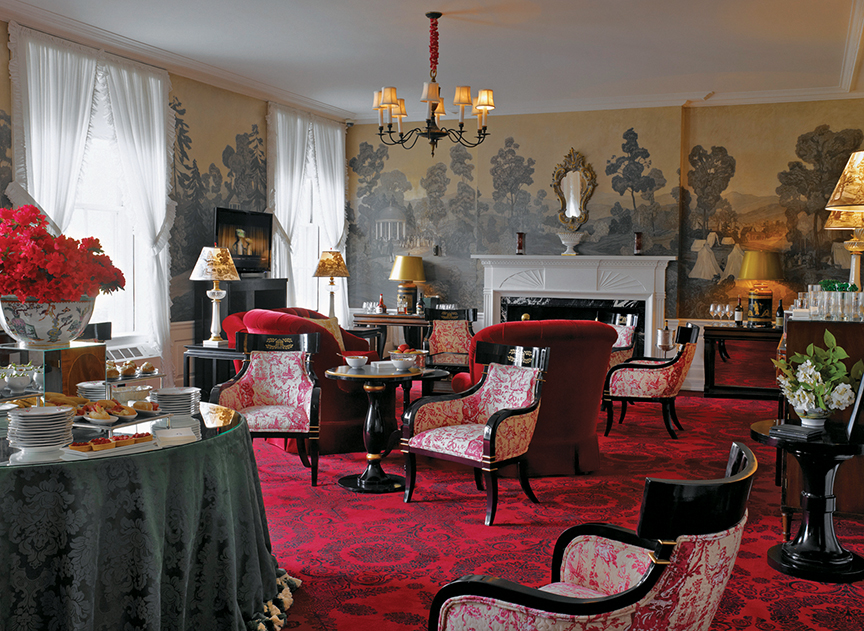
In most hotels, the “Presidential Suite” will never host a U.S. president, but its very presence suggests a property possesses the requisite luxury for the most exclusive clientele. It is an opportunity for interior designers and staff to pull out all the stops to create the ultimate accommodations for heads of state, A-List celebrities or billionaire entrepreneurs.
Since James Monroe held the office, U.S. presidents have gravitated to The Greenbrier, the stately West Virginia resort 250 miles southwest of Washington, D.C., now a short flight aboard Air Force One. Surrounded by 11,000 rolling, wooded acres, the retreat has the serenity of Camp David but with world-class golf and cuisine. After a visit from President Eisenhower in 1956, a secret Cold War bunker was constructed at The Greenbrier for the relocation of Congress in the event of a nuclear attack.
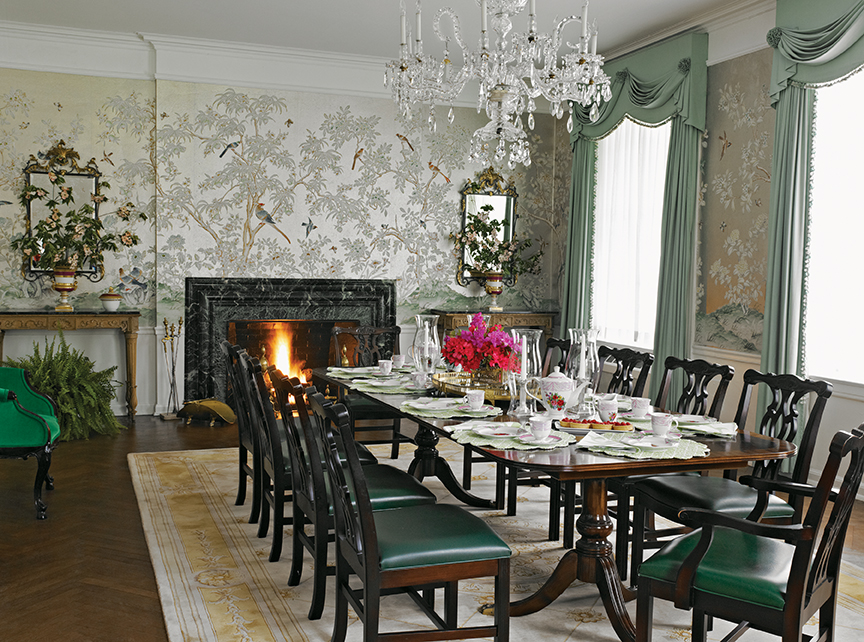
Photos courtesy of The Greenbriar
The Presidential Suite is located in a wing called The Windsor Club at The Greenbrier, and currently commands $25,000 per night. A sweeping staircase leads from the entertainment areas on the ground floor to seven bedrooms (all with en suite bathrooms) above. An additional 18 bedrooms for guests or staff are available upon request. Originally decorated by legendary interior designer Dorothy Draper, the Presidential Suite still features her signature style of American Baroque furniture and vibrant hand-painted wallpaper.
According to Dr. Robert S. Conte, the resort’s official historian and author of The History of The Greenbrier—America’s Resort, the suite was created in 1947 when the property was converted back to a hotel after serving as a U.S. Army hospital during World War II. “It’s at the end of a long corridor, which provides a sense of privacy and has a dedicated concierge,” reports Conte.
Of the 27 presidents who have stayed at The Greenbrier, only Eisenhower actually slept in the Presidential Suite, as other suites offer more manageable spaces. But its occupants have included Indian Prime Minister Nehru, as well as the Duke and Duchess of Windsor. The 5,500-squre-foot suite is ideal for corporate entertaining, and one family has made a tradition of booking it every Christmas for 25 years.
On the 51st floor of the I.M. Pei-designed Four Seasons Hotel in Midtown Manhattan are a pair of beautifully appointed 1,350-square-foot “Presidential Suites” with stunning views of the New York skyline and neighboring Central Park. But heads of state, royalty or big-name celebrities may prefer to ascend to the Ty Warner Penthouse, a 4,300-square-foot suite with 360-degree views and extraordinary appointments. The Four Seasons reports the showcase suite, a collaboration of Pei, hotel owner Ty Warner and iconoclastic architect/interior designer Peter Marino, is the product of a $50 million investment.
The Ty Warner Penthouse features the four highest cantilevered glass balconies in the world, perched over one of New York’s most prestigious and strategic addresses. A breathtaking library offers a 26-foot cathedral ceiling, floor-to-ceiling bronze bookcases from French sculptor Claude Lalanne and a Bösendorfer baby grand piano. Lacquered walls with inlaid mother-of-pearl detailing, world-class art and a master bath clad in rare Chinese onyx contribute to the architectural drama, while service perks include a 24-hour dedicated guest manager and Rolls Royce with driver at the ready. The nightly rate for this opulence is about $60,000, arguably a bit pricy for a public servant.
The Presidential Suite is located in a wing called The Windsor Club at The Greenbrier, and currently commands $25,000 per night. A sweeping staircase leads from the entertainment areas on the ground floor to seven bedrooms (all with en suite bathrooms) above. An additional 18 bedrooms for guests or staff are available upon request. Originally decorated by legendary interior designer Dorothy Draper, the Presidential Suite still features her signature style of American Baroque furniture and vibrant hand-painted wallpaper.
According to Dr. Robert S. Conte, the resort’s official historian and author of The History of The Greenbrier—America’s Resort, the suite was created in 1947 when the property was converted back to a hotel after serving as a U.S. Army hospital during World War II. “It’s at the end of a long corridor, which provides a sense of privacy and has a dedicated concierge,” reports Conte.
Of the 27 presidents who have stayed at The Greenbrier, only Eisenhower actually slept in the Presidential Suite, as other suites offer more manageable spaces. But its occupants have included Indian Prime Minister Nehru, as well as the Duke and Duchess of Windsor. The 5,500-squre-foot suite is ideal for corporate entertaining, and one family has made a tradition of booking it every Christmas for 25 years.
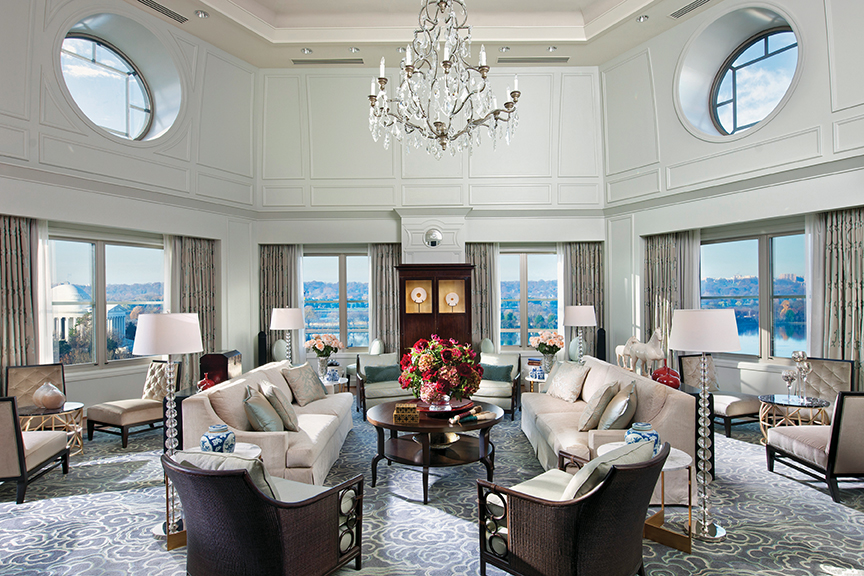
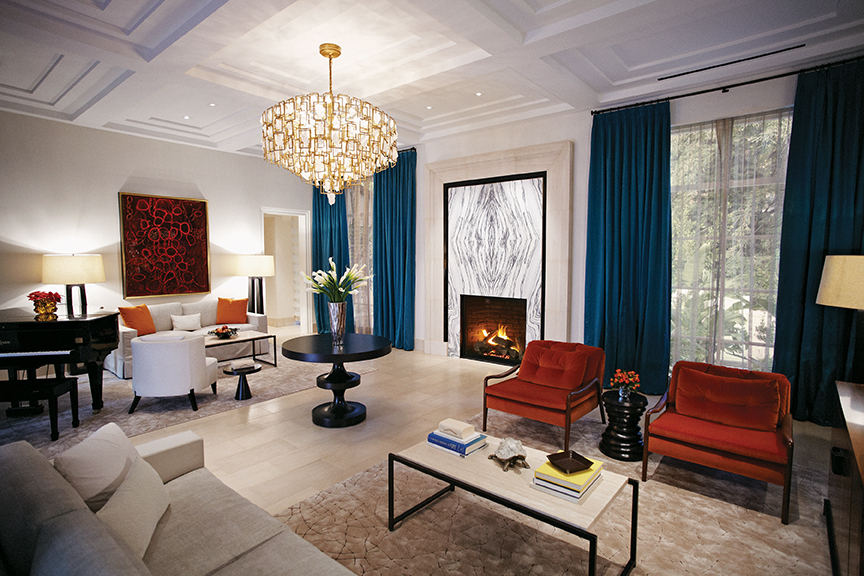
Photos courtesy of Caesar’s Hotel and Bel Air Hotel
On the 51st floor of the I.M. Pei-designed Four Seasons Hotel in Midtown Manhattan are a pair of beautifully appointed 1,350-square-foot “Presidential Suites” with stunning views of the New York skyline and neighboring Central Park. But heads of state, royalty or big-name celebrities may prefer to ascend to the Ty Warner Penthouse, a 4,300-square-foot suite with 360-degree views and extraordinary appointments. The Four Seasons reports the showcase suite, a collaboration of Pei, hotel owner Ty Warner and iconoclastic architect/interior designer Peter Marino, is the product of a $50 million investment.
The Ty Warner Penthouse features the four highest cantilevered glass balconies in the world, perched over one of New York’s most prestigious and strategic addresses. A breathtaking library offers a 26-foot cathedral ceiling, floor-to-ceiling bronze bookcases from French sculptor Claude Lalanne and a Bösendorfer baby grand piano. Lacquered walls with inlaid mother-of-pearl detailing, world-class art and a master bath clad in rare Chinese onyx contribute to the architectural drama, while service perks include a 24-hour dedicated guest manager and Rolls Royce with driver at the ready. The nightly rate for this opulence is about $60,000, arguably a bit pricy for a public servant.
On the other coast, a favorite spot of the rich and famous is the Hotel Bel-Air, whose attraction is not only its prestige but its seclusion. Buffered by 12 acres of landscaped gardens with an idyllic swan pond, the hotel’s Presidential Suite is understatedly elegant, with arched floor-to-ceiling windows, chandeliers hanging from coffered ceilings and luxurious limestone floors more suggestive of a grand residence than a hotel. A stunning Bianco Ondulare marble-clad fireplace and grand piano occupy the living room, while gracious dining for 10 is accommodated in a room with silver-laced, hand-painted walls. Guests pass through French doors into a private courtyard with its own swimming pool, reflective of the signature serenity of the entire property.
The Bel-Air’s versatile 6,775-square-foot Presidential Suite, for which the nightly rate starts at $15,000, is accessed through a private entrance ensuring privacy and providing a more residential feel. “The suite is situated in a compound layout, so anyone traveling with security or an entourage can have connecting suites or rooms,” explains Kayal Moore, assistant director of rooms at the Bel-Air. Addressing the enhanced service that complements the environment, he says, “We truly offer a unique and tailored stay for each guest.”
Everything on the Las Vegas Strip, where there is a different standard for conspicuous consumption, is over-the-top, so it should come as no surprise that the premier accommodations at the city’s iconic hotels are truly spectacular. Many decadent suites are set aside for high rollers at Caesar’s Palace (none officially titled “Presidential Suite”), some whose pink onyx bathtubs with 24-karat gold fixtures are better suited for pleasure than official business.
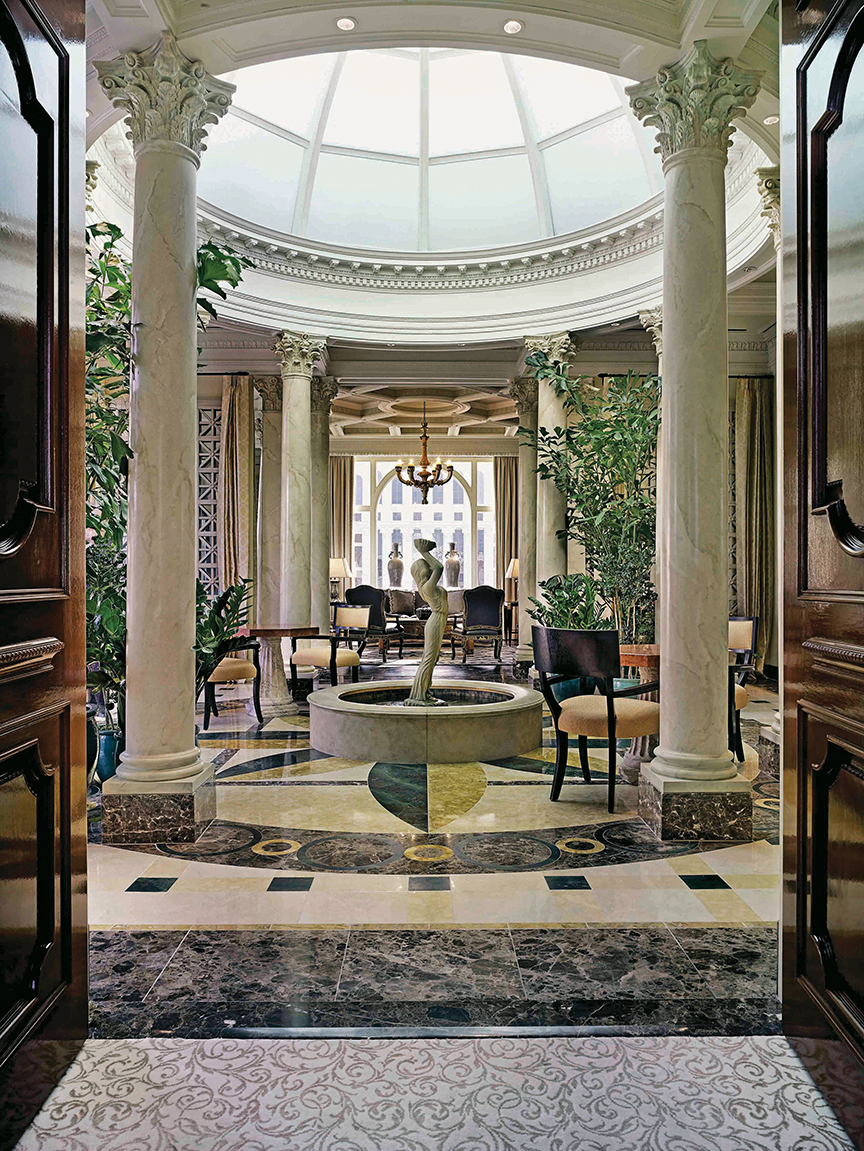
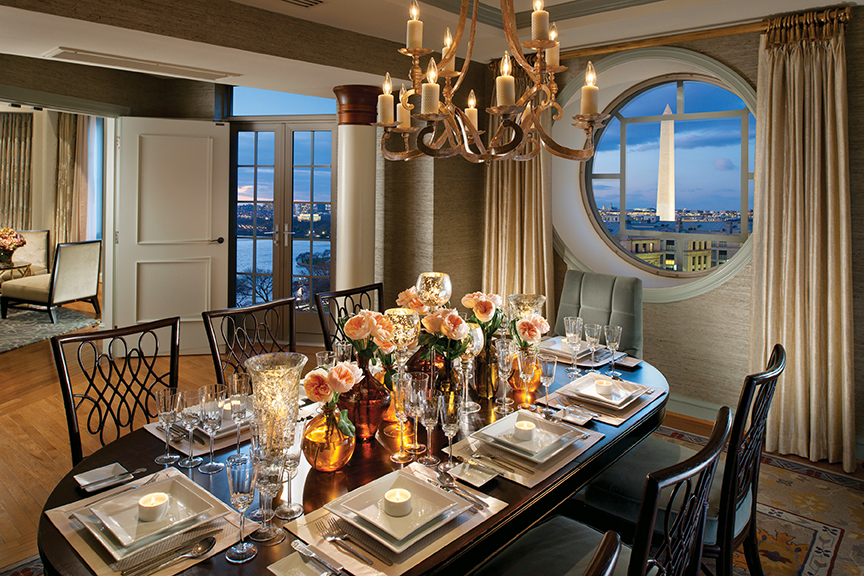
Photos courtesy of Caesar’s Palace
When President Obama and family stayed at Caesar’s, they occupied the Cleopatra Villa and the adjoining Mark Antony Villa, totaling 20,000 square feet of lavish, marble-clad space with a glass-covered atrium, six bedrooms and an oversized outdoor spa. “Now that I’m president, they upgraded me,” Obama reportedly joked during his 2009 stay, acknowledging the over-the-top accommodations. The two combined suites, priced from $33,000 per night and favored by platinum record pop stars, royal families and tech tycoons — are accessed by secure private elevator and served by a dedicated butler 24 hours a day.
The Venetian, Las Vegas’ luxury Italianate hotel, offers not one but four Presidential Suites that combine understated elegance with a little glitz, consistent with a property that values artistic expression. Each suite’s 5,200 square feet of living space includes grand marble foyers, lavish dining rooms and a pair of bedrooms with elegant amenities. Naturally, the occupants have access to any of the hotel’s acclaimed chefs and can relax over a game of billiards in a stately game room. Hotel representatives report the Chairman Suites at The Venetian’s adjoining sister property, The Palazzo, are larger, flashier and even more befitting the highest of rollers.
Clearly, Washington, D.C. knows how to accommodate diplomats, prime ministers and sultans, with suites pre-approved by the Secret Service. The Presidential Suite at the Mandarin Oriental, which has nightly rates starting at $15,000, offers spectacular views of the nation’s capital and traditional yet exquisite décor. A hexagonal living room with vaulted ceiling and crystal chandelier adds to the ease of entertaining in this 3,500-square-foot suite, where stunning spa-like contemporary bathrooms — the master features a two-person glass shower — adjoin spacious sleeping quarters.
Hotel manager Marie-Elise Lallemand insists the Mandarin Oriental’s Presidential Suite is the only one in the District with genuinely monumental views, noting its 180-degree panorama encompasses many of the capital city’s most recognizable landmarks. In fact, a circular window in the 10-seat dining room perfectly frames a postcard-worthy vista of the Washington Monument. “With two bedrooms, two-and-a-half baths, dining room with chef’s prep area, living room, office, sitting room, and grand foyer, our Presidential Suite is truly unique,” says Lallemand, who maintains the level of service is commensurate with the presidential premises.
Sweet Suites
Hotel Bel-Air • Los Angeles • www.dorchestercollection.com
Caesar’s Palace • Las Vegas • www.caesars.com
Four Seasons • New York • www.fourseasons.com
The Greenbrier • Sulphur Springs • West Virginia • www.greenbrier.com
Mandarin Oriental • Washington, D.C. • www.mandarinoriental.com
The Palazzo • Las Vegas • www.palazzo.com
The Venetian • Las Vegas • www.venetian.com














